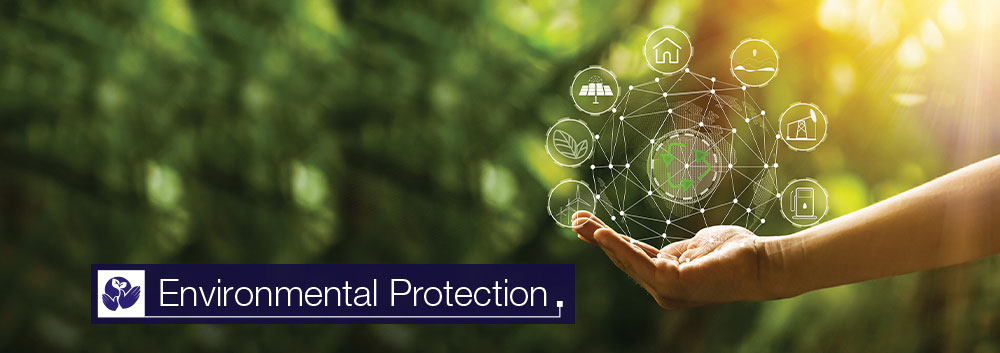
Environmental Protection
Management Approach
Environmental protection is fundamental to the Company’s sustainability strategy. In view of challenges such as climate change, pollution and scarcity of resources, Atlas Honda aims to be the most resource-efficient mobility solution provider in Pakistan. The Company’s focus lies on increasing the energy and resource efficiency of its production processes and on reducing emissions and waste. These measures allow the Company to minimize impacts on the environment, make a contribution towards achievement of Honda’s environmental vision and reduce costs. Environment related issues arising from energy & resource consumption, emissions, effluents & waste and water are managed by the Company’s Production & HSE departments in coordination with other departments. Necessary procedures are defined and implemented to achieve targets. The Company has a continuously evolving Environmental Management System (EMS) in place which is supported by the Company’s Environmental Policy to ensure effectiveness of processes, monitoring and continual improvement in the Company’s environmental performance. The Company also engages with local communities on regular basis to assess environmental impact of its operations. Company also publishes its Annual sustainability at its website to make public disclosure of its environmental assessment.
Green practices are being implemented at all locations of the Company and those of its business partners. Awareness is being raised by the Company through continuous training and development programs for its suppliers as well as employees. In recognition of its efforts for protection of environment, the Company has been presented with Awards by National Forum for Environment & Health (NFEH), for the year 2020, in the category of Environment & Waste Management.
Environmental Policy
The Company’s Environmental Policy covers every aspect of the Company’s operations, whether they are directly or indirectly related to designing, engineering, manufacturing, distribution and service:
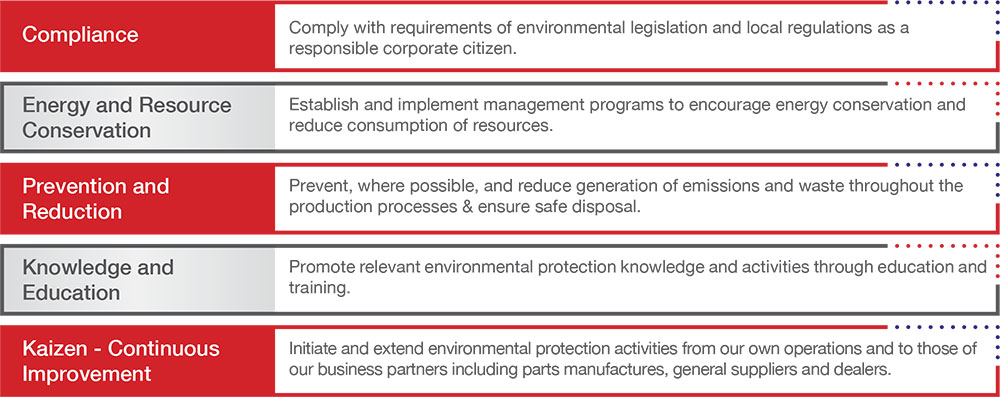
Environment Management System (EMS)
EMS is intended to formalize procedures for managing and reducing environmental footprint. It helps the Company organize and analyze, in a timely manner, the environmental impacts that result from its business operations. It also helps the Company in developing solutions to address those impacts. The Company’s EMS is based on relevant legislation such as the Pakistan Environmental Protection Law, international standards and Honda’s guidelines, as well as best practices. The management system is certified in accordance with ISO 14001:2015, an international certification for EMS.
The Company conducts internal and external audits of its EMS and strives for further improvement. During the year, the Company identified tasks as a result of in-house reviews and made improvements accordingly. Periodic visits by representatives from Environmental Protection Agency (EPA) are also facilitated to ensure compliance with regulatory requirements.
No non-compliances have been reported during the year. Further, no environment-related complaints were received through the Company’s formal grievance mechanism during the reporting period.
Life Cycle Assessment
The Company applies a product life cycle approach for management of environmental impacts, which considers the entire life cycle – from product development to purchasing, manufacturing, sales & service, use, recycling and administration. This approach makes it easier to identify opportunities, minimize or enhance impacts and understand boundaries in every aspect of the Company’s business. It also helps the Company understand how its actions and impacts are interrelated. The Company also applies the precautionary principle, whereby it acts responsibly despite not having the full scientific knowledge of negative impacts, to ensure the Company stays ahead of potential risks.
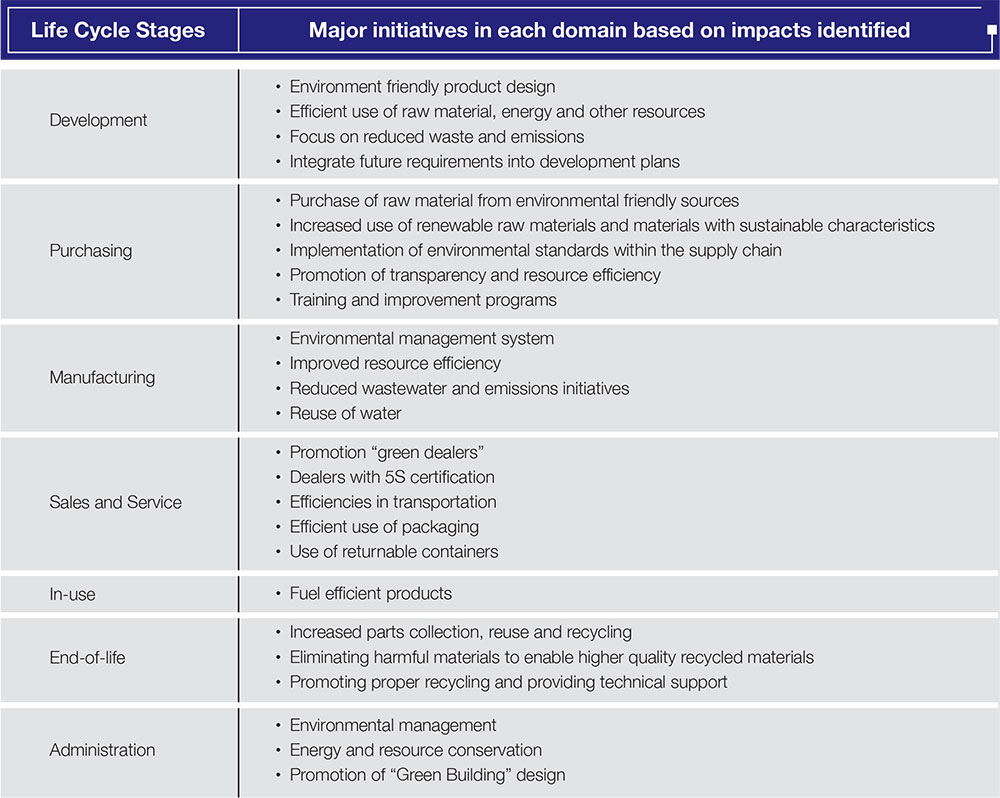
Energy Consumption
The Company monitors energy consumption and emissions on regular basis to identify and incorporate best practices and to improve the Company’s energy management. Both the Company’s manufacturing plants are located away from protected areas to minimize the effects of CO2 and other greenhouse gases on such areas. The Company’s primary sources of energy are grid based electricity, natural gas and diesel. Other sources include solar energy. Currently only a small part of the total energy is being derived from solar panels. However, AHL endeavors to explore possibilities of renewable energy generation and increase the share of energy generated from renewable sources on an ongoing basis. Accurate data on energy consumption and emissions is obtained from management systems. The conversion factors are sourced from U.S. Energy Information Administration. The Company uses previous year as base year to measure energy consumption and emissions. This enables the Company to address irregularities and implement necessary measures to ensure the Company’s performance is on track. Collecting comprehensive data helps in understanding not only the energy savings, but also the economic benefits that can be achieved through specific measures.
The energy consumption during the year was 414,988 GJ of which 16,379 GJ has been generated from renewable sources. Compared to 2022, the total energy consumption during the year under review decreased by 23% primarily on account of decrease in production levels. However, energy consumption per motorcycle has been brought down to 374 KJ/Motorcycle 7.5% decrease from last year, owing to new energy initiatives and process optimizations adopted as part of our green practices.
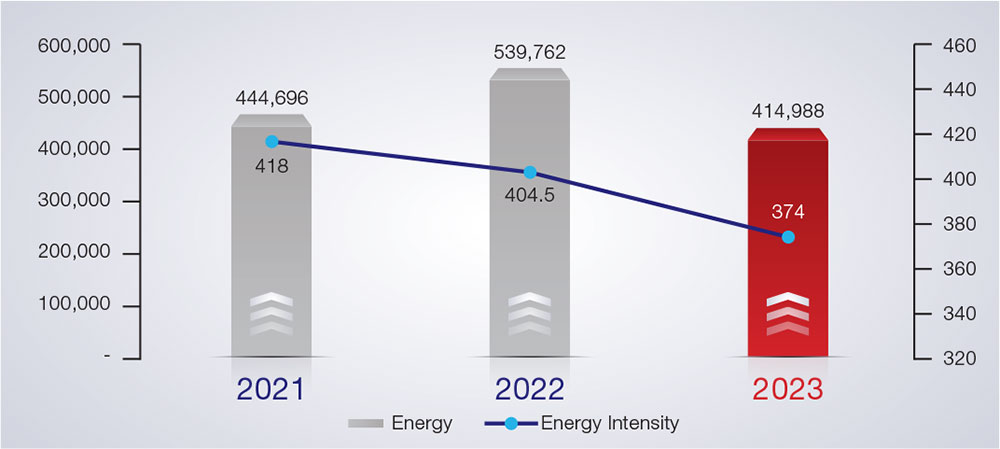
The Company operates two manufacturing facilities. The energy consumption only includes the energy that is consumed by the Organization. Energy consumption data is recorded in relevant conventional unit, for instance, MMSCF for natural gas and kWh for electricity. These units are converted into consolidated unit, gigajoules (GJ), to obtain mean energy content and as a standard measure for representing energy consumption. The heating values are based upon standard values for natural gas. The energy consumption and sources in this report have been determined from data provided by production sites of Company and present a consolidated picture of AHL’s energy consumption in manufacturing operations.
GHG Emissions
The Company’s products are in compliance with requirements of Pakistan Standards for Quality Control Authority (PSQCA) in respect of CO2 emissions, noise levels and smoke. Further, all products of the Company comply with EURO II standards of carbon emission. During the year, there has been no direct reduction in the energy requirements of the Company’s products.The emissions of GHGs are subject to control limits laid down by Environmental Protection Agency and the company ensures compliance with these limits by determining total emissions for each plant site at regular intervals and is moving further to reduce the emissions up to maximum possible limit. The Company has set both short-term and long-term targets to reduce GHG emissions. Opportunities are being explored to expedite the shift to the low carbon economy.
The direct CO2 emissions are the result of combustion processes for the generation of heat electricity and steam. Emissions of CO2 and other GHG are measured at each production facility and integrated into consolidated calculation of GHG emissions. The GHG figures only include the emissions caused by the Company. The global warming potential of the respective gaseous emissions was sourced from United Nations Framework Convention on Climate change (UNFCC).
Furthermore, AHL does not have any significant Scope-II emissions. The only scope-II emissions result from purchased electricity at marketing offices and warranty centers of the Company. Moreover, AHL identified that scope-III emissions are insignificant in the overall context except the emissions resulting from products transportation and selling. AHL is working with the transporters to apprise them of the emissions, effects of climate change and encourage them to upgrade their fleets to reduce emissions.The emissions of other inorganic pollutants such as NOX are insignificant in comparison to the overall emissions reported by the Organization for the current year. The company uses the previous year’s results for comparison as a general practice.
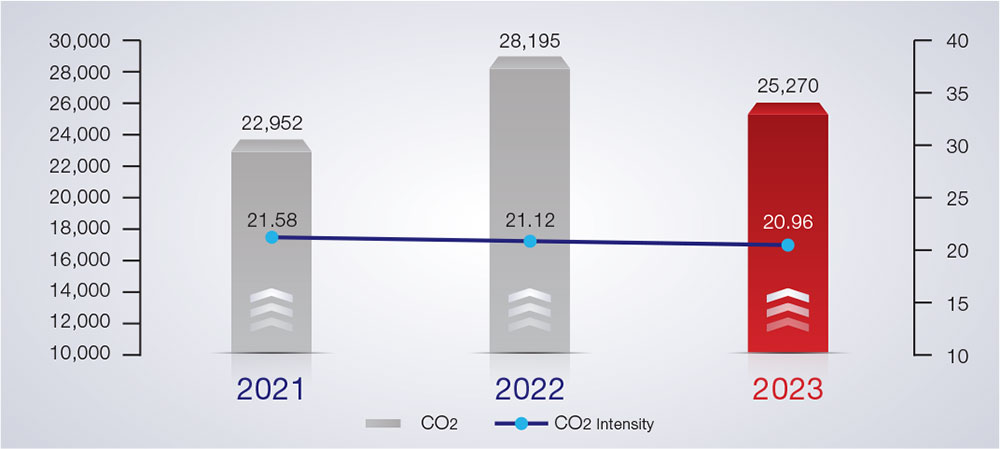
The emissions during the year were 25,270 tons mainly comprising of CO2 . However, emissions per bike have been brought down to 20.96 kg/motorcycle: 1% reduction from 2022. There were no significant emissions of ozone-depleting substances during the year. The company is committed to the non-use of ozone-depleting substances as a part of its environmental management policy. The company is in process of replacing its old air conditioners with air conditioners which use 410 gas and do not harm the ozone layer.
 Energy Conservation and Emission Reduction Initiatives
Energy Conservation and Emission Reduction Initiatives
Lack of access to energy supplies and transformation systems is a constraint to human and economic development. Increased use of fossil fuels without actions to mitigate greenhouse gases will have climate change implications. Energy efficiency and increasingly use of renewables contribute to climate change mitigation and disaster risk reduction. To reduce the Company’s energy consumption and emissions, primarily CO2 , investments have been made and energy efficiency measures have been implemented at the Company’s production facilities and offices. During the year, energy conservation of 38,468 GJ and emission reduction of 2,138 tons were achieved through following initiatives:
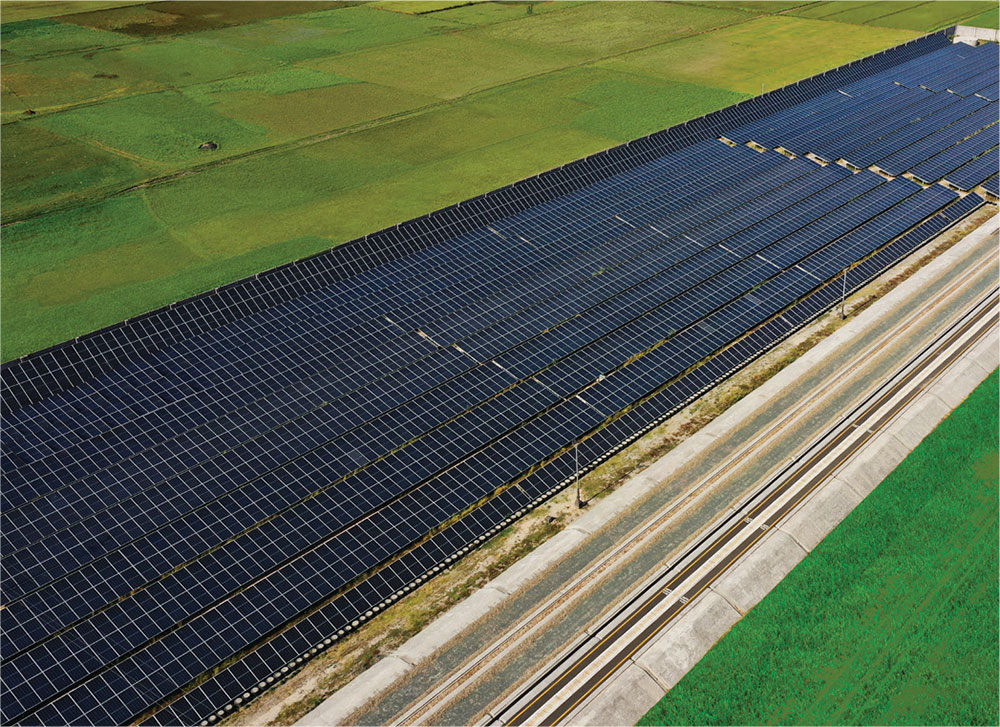
Solar Panels
The Company is determined to extend its use of renewable sources for energy. Installation of solar power systems is one of the major projects under the efforts in this area. This is aimed to derive clean & affordable energy to reduce greenhouse gas emissions and Atlas Honda’s dependence on fossil fuel or grid-based electricity. This year, the Company increased solar energy utilization from 3,955 to 8,500 KW during the year. This initiative will help to generate 16,379 GJ of energy from renewable resources and reduce CO2 emissions by 2,138 tons every year.
Energy Optimization at paint line through reduction in operating air presssure
Previously nozzles with diameter of 8 mm with air pressure of 6 bar were used to clean parts. The Company during the current year replaced these with nozzles of diameter 5 mm with 5 bar air pressure without compromising over the quality. This reduced the compressed air consumption by 54,864 m3 which resulted in energy conservation of 1,500 GJ and reduction in CO2 by 177 Tons per annum.
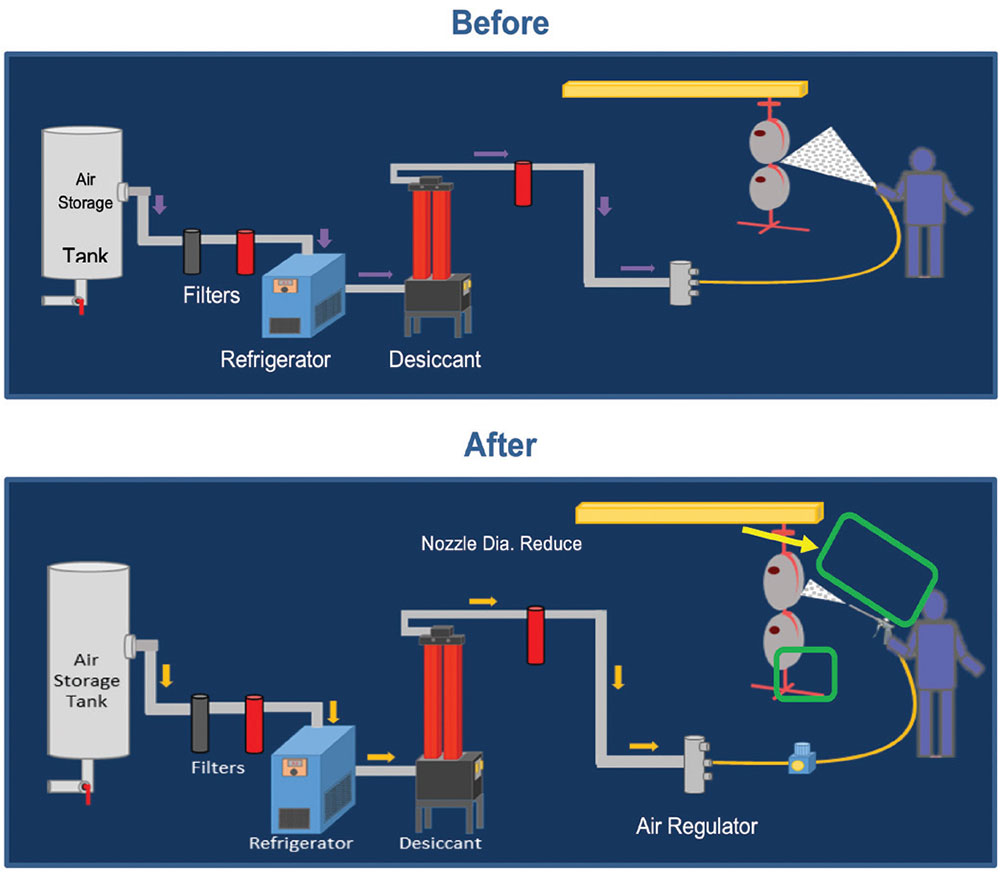
Energy Conservation at manufacturing plant through efficient Usage of Compressed Air in Air Micrometers
Previously there was continuous air flow to the gauges at fine boring machines for 17 hours every day. For efficient air utilization, Teflon bushes have been designed with two wire sensors along with a new pneumatic circuit with solenoid valve to cut-off the continuous flow when needed. This has resulted in 70% reduction in compressed air consumption which decreased the energy consumption by 1700 GJ and CO2 emission by 695 Tons per annum.
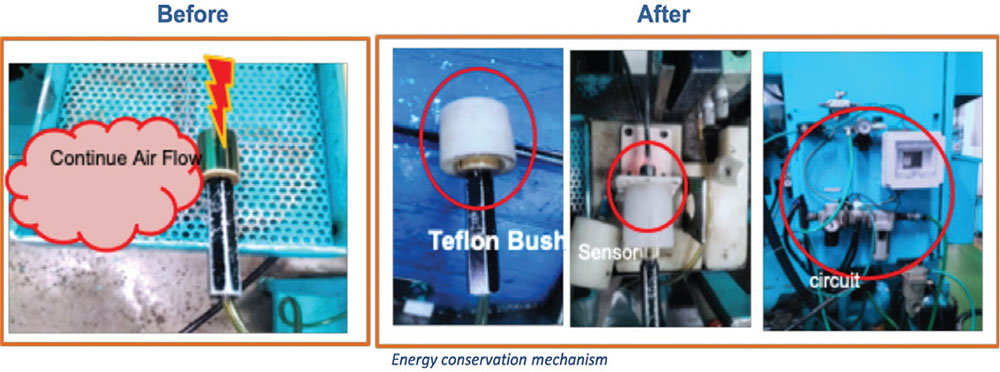
Shifting of 250KVA Genset to HT Room at Component Plant
The Company has replaced the old 250KVA Genset with the updated technology and efficient generator which has reduced the annual fuel consumption for said by more than 70% and as a result of which energy consumption has been reduced by 5,117 GJ during the year and reduced the CO2 emissions by 605 Tons per annum.
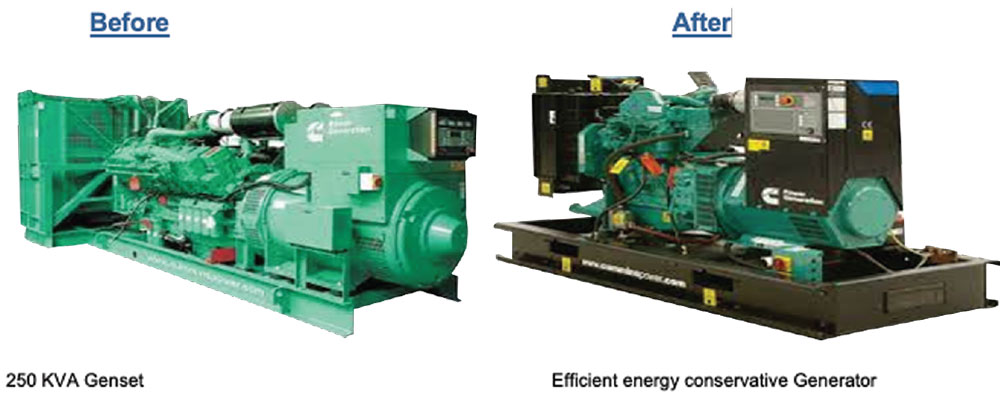
Energy Consumption reduction via Reducing the air nozzles diameter
Previously at Hi-Tech plant of the Company, a total of 86 compressed air guns were used for machines cleaning, with a nozzle diameter of 3.0 mm. These have been replaced with compressed air guns with nozzle diameter of 1.5mm, without effecting machines efficiency. This has halved the energy consumption required for said process which has resulted in energy reduction by 1,800 GJ and reduced the CO2 emissions by 605 Tons per annum.
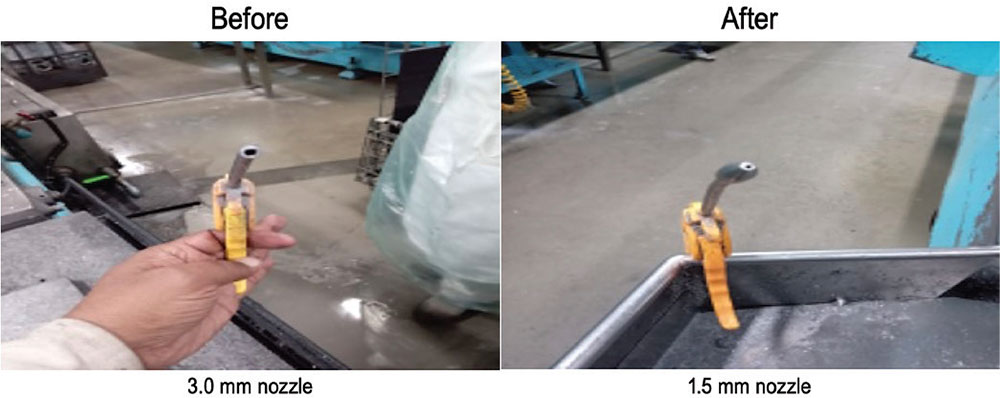
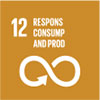 Material, Effluents & Waste
Material, Effluents & Waste
To ensure sustainable consumption and production practices necessarily entails to respect the biophysical boundaries of the planet and to reduce current consumption rates in order to fit with the biophysical capacity to produce ecosystem services and benefits. At Atlas Honda, environmental friendly use of raw materials is taken into account as early as the development phase through life cycle engineering. The Company’s supply chain and material cycles have been shaped accordingly. Natural resources are being used in the most efficient manner with the objective to minimize depletion of the planet’s resources. The Company is working to replace artificial materials with renewable materials wherever it makes technical, business and environmental sense and is socially viable. Consumption of raw materials, having substantial impact on the environment, is closely monitored and treated according to the Company’s environment policy. The rejection percentage is less than 0.1% of the incoming parts, the rejected parts are reworked as per the quality standard to ensure minimum wastage of materials. Consumption of the materials and waste generation reported by the Company only include material consumed and waste generated by the Company. Following table shows the materials used:
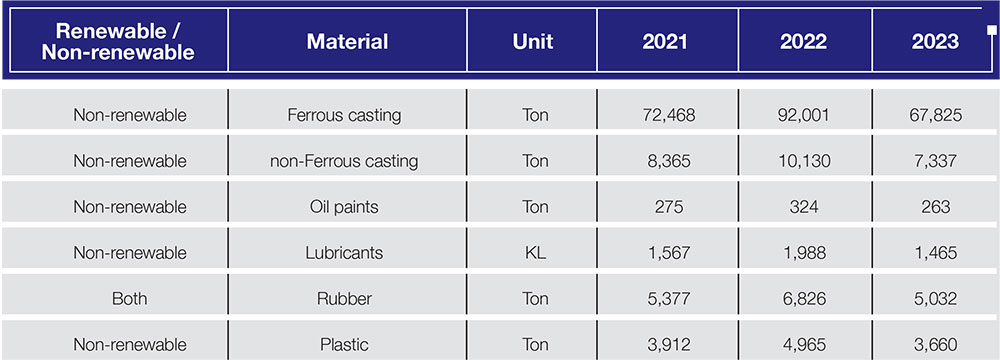
Waste resulting from the Company’s production processes mainly includes waste water, metal, plastic & rubber scrap, packing & used oil. Considering water-related environmental impacts from our discharged water, waste water is treated through Waste Water Treatment Plant before it is released in sewerage drains to control the negative impacts and promote a healthy environment. The remaining waste and effluents are discharged through incineration, recycling, landfill and disposal to legitimate contractors at certified waste disposal facilities. During the year, 10,242 tons of waste was released. There were no significant spills during the year by the Company nor were any reported by the external stakeholders through the grievance reporting mechanism in place.
During the year, 8,373 tons of waste was released with the reduced intensity of 6.4% per motorcycle. Furthermore, there were no significant spills during the year.
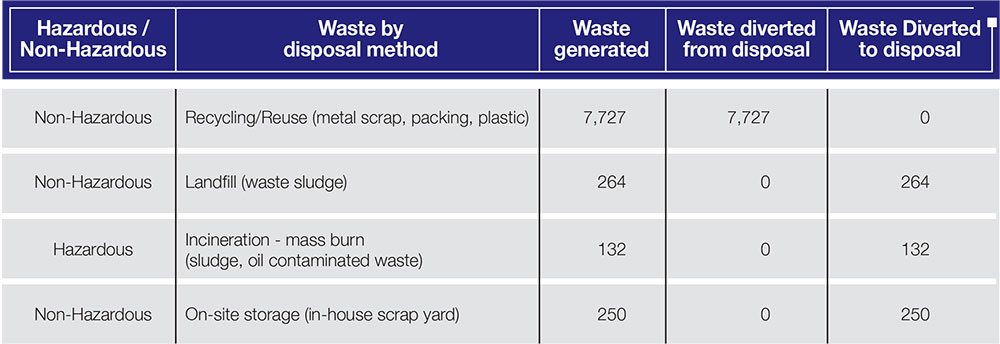
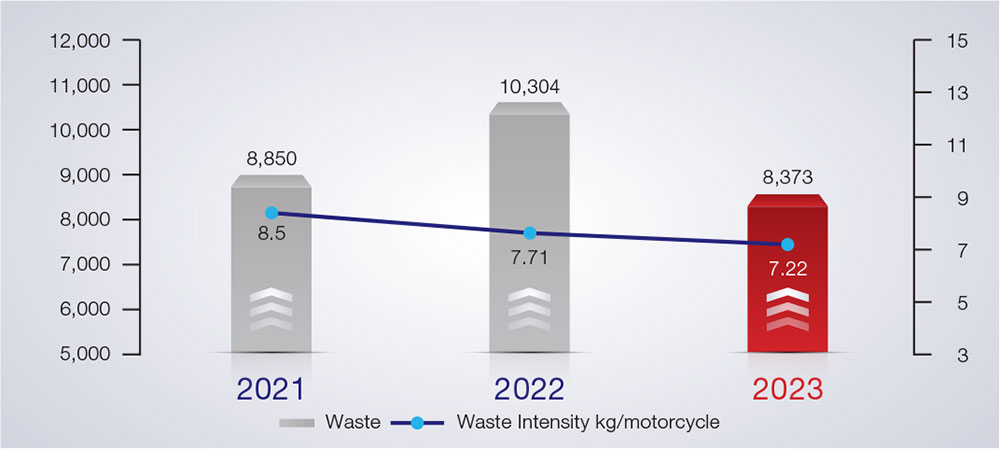
Recycling of aluminum waste
During the year the Company recycled 442 tons of aluminum waste which is generated as part of its various production processes. This has reduced from last year, however during the current year this has increased from 5% to 6% of total non-ferrous casting material consumed by the Company.
 Water
Water
The Company seeks to reduce its water footprint by promoting
water-saving practices amongst employees and adopting water-efficient technologies and equipment wherever possible. Sustainable management of water resources and access to safe water and sanitation are essential for unlocking economic growth and productivity, and provide significant leverage for existing investments in health and education. The natural environment e.g. forests, soils and wetlands contribute to management and regulation of water availability and water quality. The Company has special focus on this goal and clean drinking water and sanitation facilities are ensured at all the business offices. The majority of the Company’s water use is attributable to its production processes, cooling and water consumed by employees. Main areas of action are thoughtful use and reuse of water and safe disposal of treated wastewater.
Water consumption and discharge is recorded through flow meters installed at tube wells, water tanks and water treatment plant which are used to monitor the water consumption by the organization. During the year, 596,872 cubic meters of water was consumed with a reduced intensity of 2.5 % as compared to the last year. More than 90% of the water used in the production processes, is extracted from ground water while remaining is obtained from sources of fresh water. Company assess its plant sites on regular basis for water-related risks and monitor water withdrawal, consumption, and discharges. Frequent studies are conducted to identify opportunities for reduced consumption and increased recycling to minimize requirements from freshwater sources. During the year, no non-compliance with the water withdrawal permit occurred.
The water is partially polluted during use in production processes and is treated to reduce the pollutants to acceptable limits, prescribed by National Environmental Quality Standards (NEQS), before using and discharging into the drain. After proper treatment, water used in manufacturing process is discharged in sewerage system. Such treatment removes pollutants from the water that contains chemical contaminants, nutrient pollution, oil
& grease, and suspended solids. This process makes the same suitable for safe drainage. No water bodies or related habitats were significantly affected by water discharges of the Company as these areas are not designated as protected areas.
During the year, 89,530 cubic meters (15%) of the water was recycled.
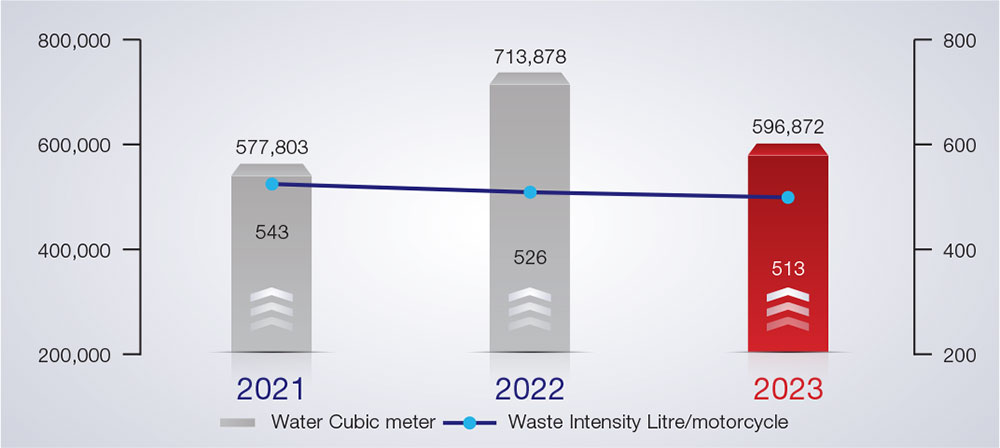
 Waste Water Treatment Plant
Waste Water Treatment Plant
Water is used throughout the Company’s production processes which results in wastewater. To prevent the wastewater from being discharged, waste water from all over the plant is collected and treated to remove the harmful pollutants, at two Waste Water Treatment Plants at manufacturing sites of the Company. The profile of the receiving waterbody is however, not considered due to safe drainage after treatment. The Company, as a responsible organization abides by the legal requirements of waste water treatment as well as meets “Punjab Environmental Quality Standards”. This year, around 518,005 cubic meter of water was
treated and safely drained into the sewerage.
Water Conservation through Recycling
Previously alkali water tank and hot water tank used in two washing machines were drained after every three months due to cleaning of nozzles and tank interior. To reduce the water consumption and water discharge, drain tank underneath the 2 water tanks, is now being used as storage tank to temporary store water and recycle to the 2 tanks after cleaning process. This has reduced the water discard cycle from 4 times to 1 time in a year reducing the annual water consumption by 72,000 liters.
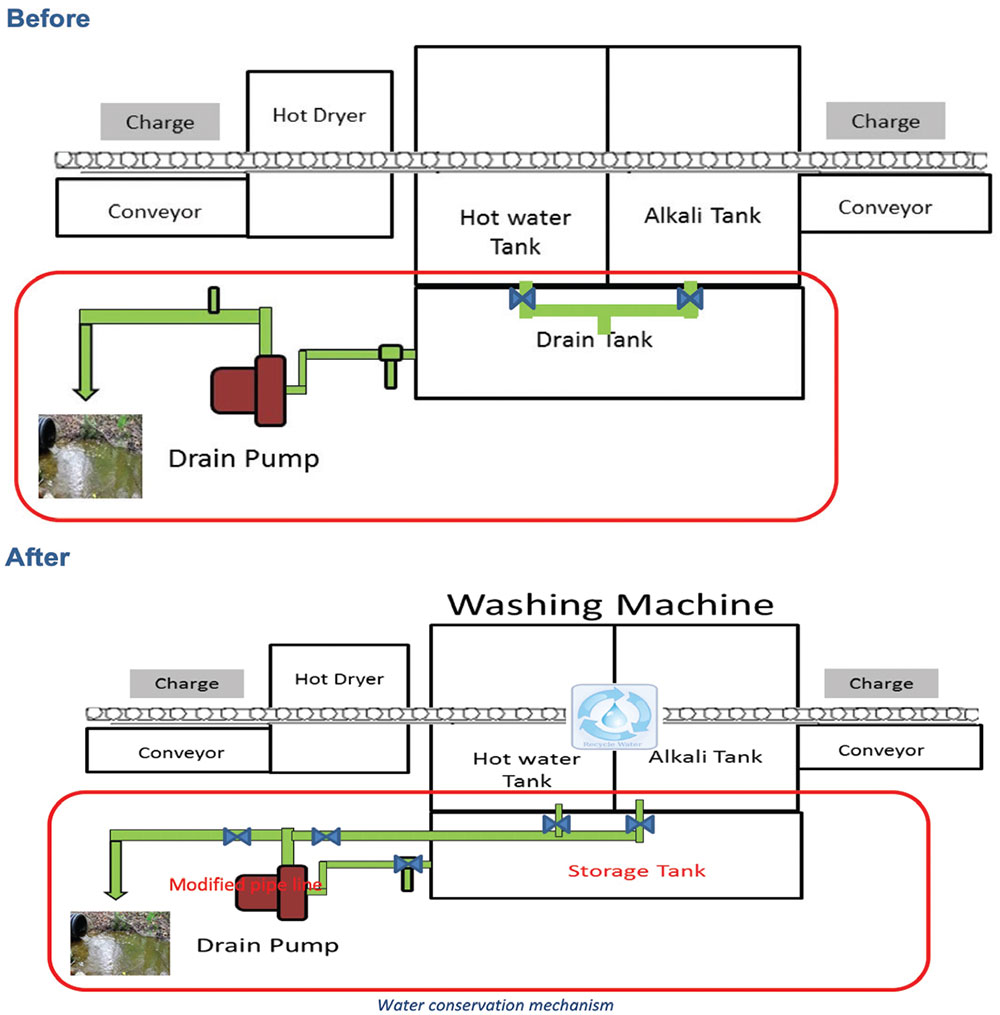
 Biodiversity
Biodiversity
The Company has clear vision from the onset of its business related to environment protection, therefore both of the manufacturing plants have been located away from protected areas to minimize the effects of CO2 and greenhouse gases on the protected areas.
With reference to the Environment statement, the Company considers biodiversity conservation initiatives as imperative part of our commitment to the preservation of the environment. The Company will work incessantly towards the harmony between the commitment and its activities. Following are the broad guidelines related to biodiversity:
- Company will continue to channelize efforts towards the development of technologies for fuel-efficient vehicles and other technologies for the reduction of environmental impacts;
- Environmental impacts will be minimized by the effective use of resources through efficiency improvements;
- Community-based activities will be implemented in cooperation with stakeholders; and
- Company will promote transparency of information related to the outcomes of its activities.
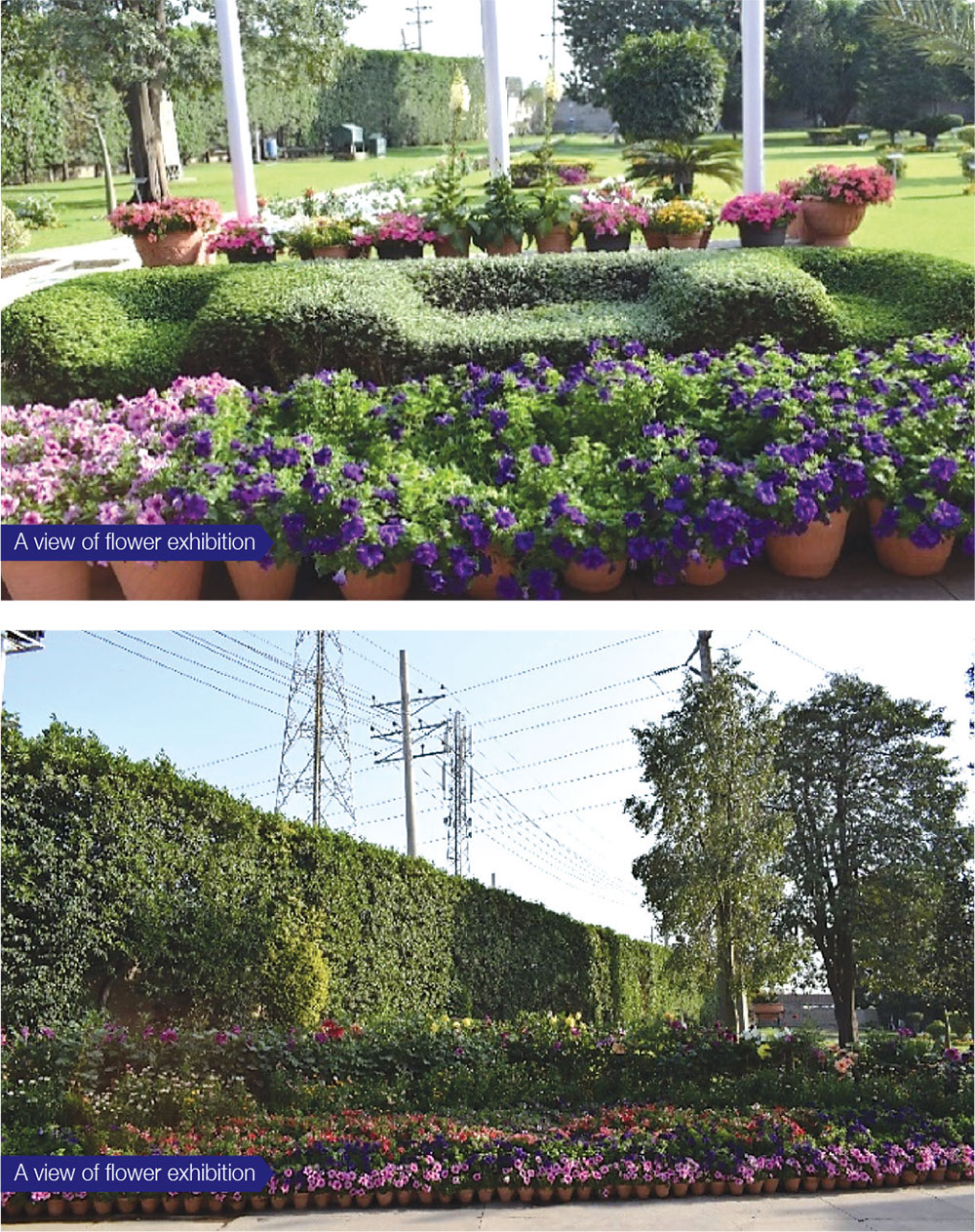
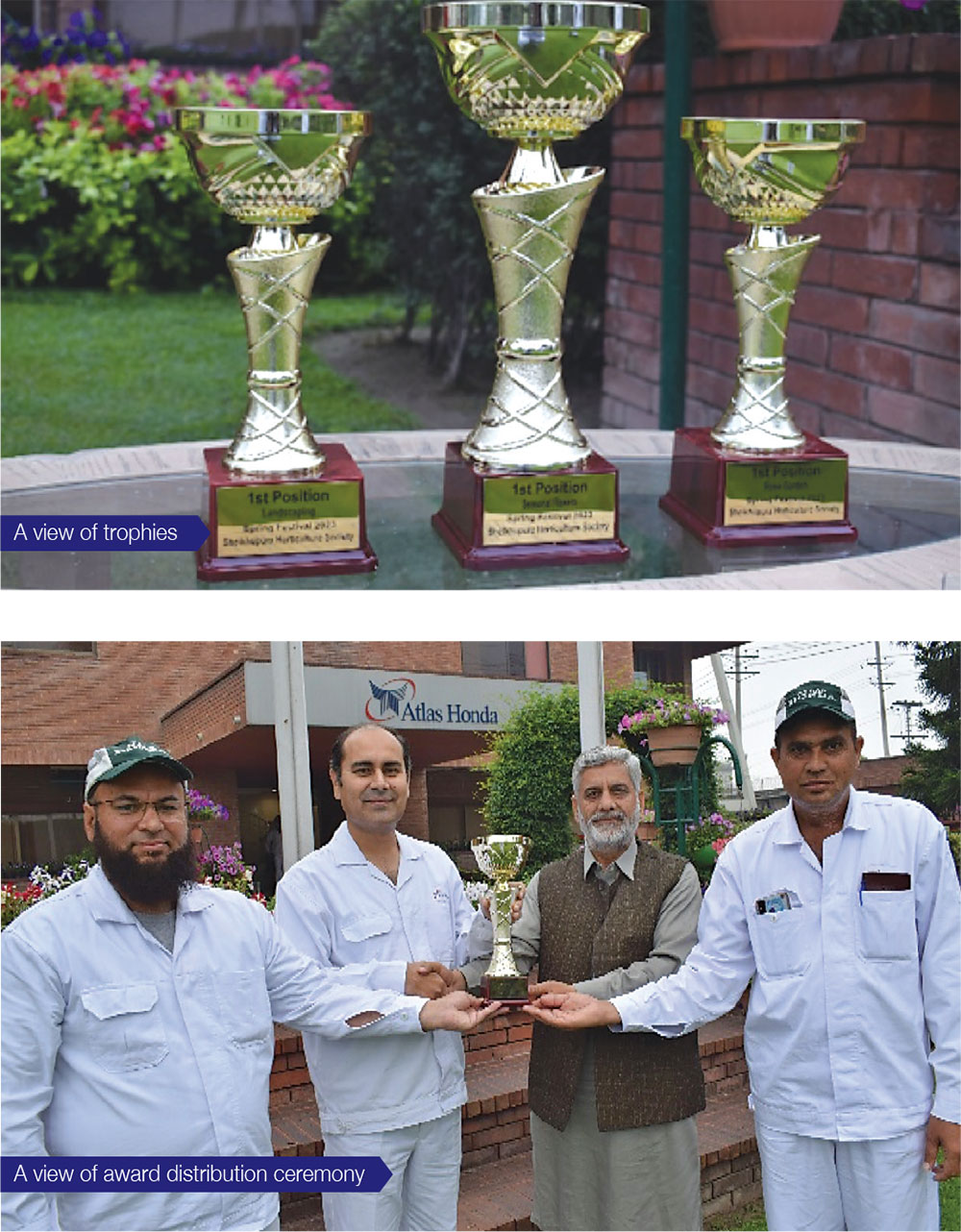
 Plantation of Trees
Plantation of Trees
Over the years, the Company has been undertaking initiatives such as tree plantation to negate the impact of greenhouses gases. These activities cover in-house plantation of trees as well as those planted at schools, government institutes and reservoirs in collaboration with Environmental Protection Agency. During the year, 3,000 trees were planted directly by the Company, and 5,500 trees were planted in collaboration with the Government departments.
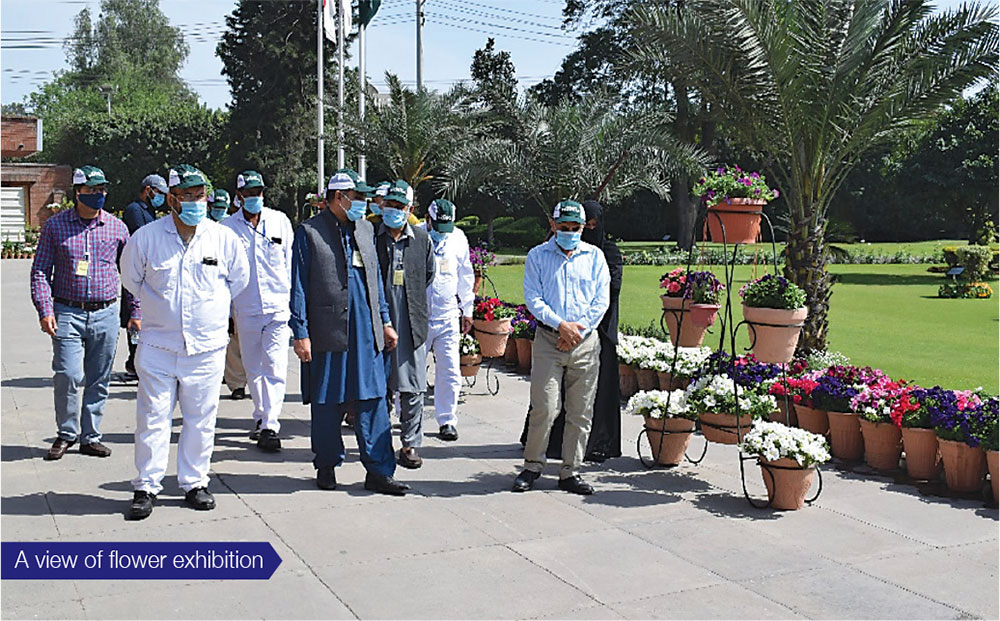

Environmental Protection
Management Approach
Environmental protection is fundamental to the Company’s sustainability strategy. In view of challenges such as climate change, pollution and scarcity of resources, Atlas Honda aims to be the most resource-efficient mobility solution provider in Pakistan. The Company’s focus lies on increasing the energy and resource efficiency of its production processes and on reducing emissions and waste. These measures allow the Company to minimize impacts on the environment, make a contribution towards achievement of Honda’s environmental vision and reduce costs. Environment related issues arising from energy & resource consumption, emissions, effluents & waste and water are managed by the Company’s Production & HSE departments in coordination with other departments. Necessary procedures are defined and implemented to achieve targets. The Company Environment Management System (EMS) EMS is intended to formalize procedures for managing and reducing environmental footprint. It helps the Company organize and analyze, in a timely manner, the environmental impacts that result from its business operations. It also helps the Company in developing solutions to address those impacts. The Company’s EMS is based on relevant legislation such as the Pakistan Environmental Protection Law, international standards and Honda’s guidelines, as well as best practices. The management system is certified in accordance with ISO 14001:2015, an international certification for EMS. The Company conducts internal and external audits of its EMS and strives for further improvement. During the year, the Company identified tasks as a result of in-house reviews and made improvements accordingly. Periodic visits by representatives from Environmental Protection Agency (EPA) are also facilitated to ensure compliance with regulatory requirements. There were no non-compliances reported during the year and no significant fines or non-financial sanctions were imposed on company for any environmental non-compliance. Further, no environment-related complaints were received through the Company’s formal grievance mechanism during the reporting period. has a continuously evolving Environmental Management System (EMS) in place which is supported by the Company’s Environmental Policy to ensure effectiveness of processes, monitoring and continual improvement in the Company’s environmental performance.
Green practices are being implemented at all locations of the Company and those of its business partners. Awareness is being raised by the Company through continuous training and development programs for its suppliers as well as employees. In recognition of its efforts for protection of environment, the Company has been presented with Awards by National Forum for Environment & Health (NFEH), for the year 2021, in the category of Environment & Waste Management.
Environmental Policy
The Company’s Environmental Policy covers every aspect of the Company’s operations, whether they are directly or indirectly related to designing, engineering, manufacturing, distribution and service:
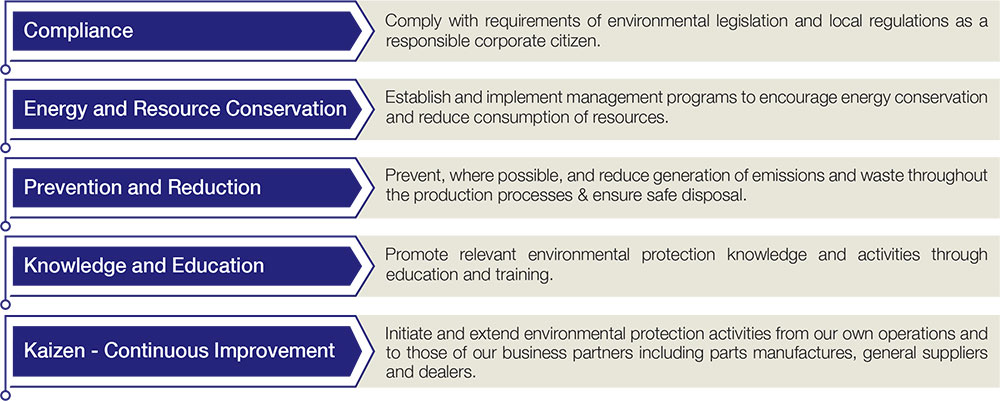
Environment Management System (EMS)
EMS is intended to formalize procedures for managing and reducing environmental footprint. It helps the Company organize and analyze, in a timely manner, the environmental impacts that result from its business operations. It also helps the Company in developing solutions to address those impacts. The Company’s EMS is based on relevant legislation such as the Pakistan Environmental Protection Law, international standards and Honda’s guidelines, as well as best practices. The management system is certified in accordance with ISO 14001:2015, an international certification for EMS.
The Company conducts internal and external audits of its EMS and strives for further improvement. During the year, the Company identified tasks as a result of in-house reviews and made improvements accordingly. Periodic visits by representatives from Environmental Protection Agency (EPA) are also facilitated to ensure compliance with regulatory requirements.
There were no non-compliances reported during the year and no significant fines or non-financial sanctions were imposed on company for any environmental non-compliance. Further, no environment-related complaints were received through the Company’s formal grievance mechanism during the reporting period.
Life Cycle Assessment
The Company applies a product life cycle approach for management of environmental impacts, which considers the entire life cycle – from product development to purchasing, manufacturing, sales & service, use, recycling and administration. This approach makes it easier to identify opportunities, minimize or enhance impacts and understand boundaries in every aspect of the Company’s business. It also helps the Company understand how its actions and impacts are interrelated. The Company also applies the precautionary principle, whereby it acts responsibly despite not having the full scientific knowledge of negative impacts, to ensure the Company stays ahead of potential risks.
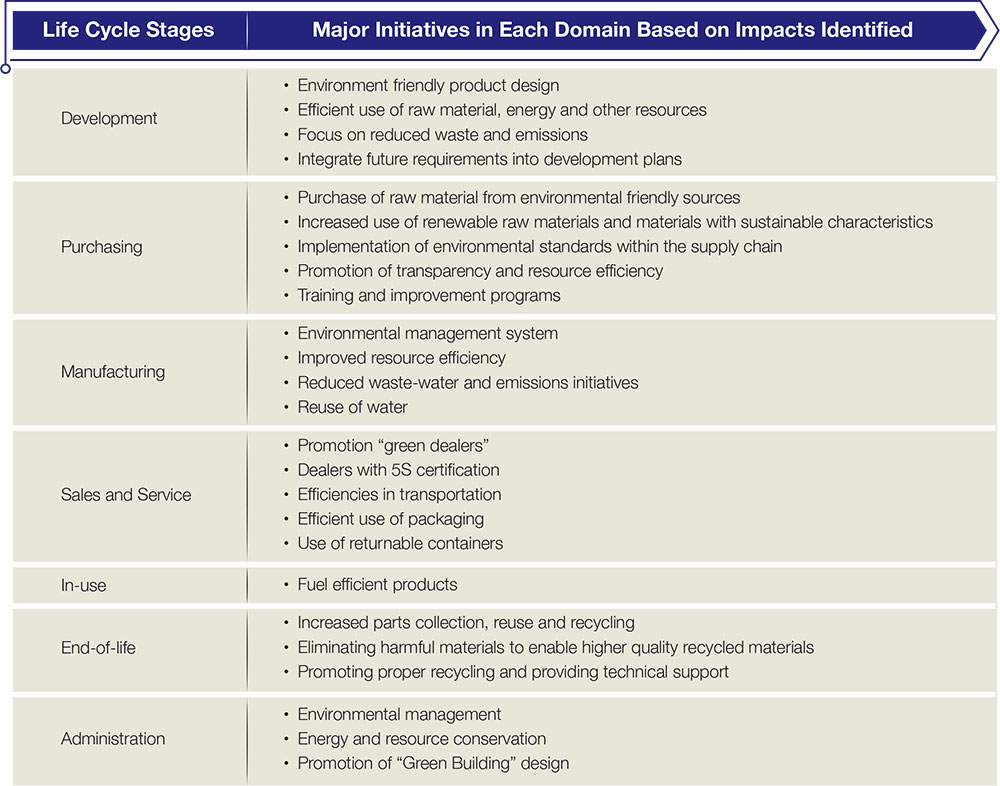
Energy Consumption
The Company monitors energy consumption and emissions on regular basis to identify and incorporate best practices and to improve the Company’s energy management. Both the Company’s manufacturing plants are located away from protected areas to minimize the effects of CO2 and other greenhouse gases on such areas. The Company’s primary sources of energy are grid based electricity, natural gas and diesel. Other sources include solar energy. Currently only a small part of the total energy is being derived from solar panels. However, the Company endeavors to explore possibilities of renewable energy generation and increase the share of energy generated from renewable sources on an ongoing basis. Accurate data on energy consumption and emissions is obtained from management systems. The conversion factors are sourced from U.S. Energy Information Administration. The Company uses previous year as base year to measure energy consumption and emissions. This enables the Company to address irregularities and implement necessary measures to ensure the Company’s performance is on track. Collecting comprehensive data helps in understanding not only the energy savings, but also the economic benefits that can be achieved through specific measures.
The energy consumption during the year was 539,762 GJ. Compared to 2021, the total energy consumption during the year under review increased by 21% on account of increased production. However, energy intensity ratio has been brought down to 404.5 KJ/Motorcycle 3.2% decrease from last year, owing to new energy initiatives and process optimizations adopted as part of our green practices. The energy consumption includes energy directly consumed by the Company and the Company uses previous year as the base year.
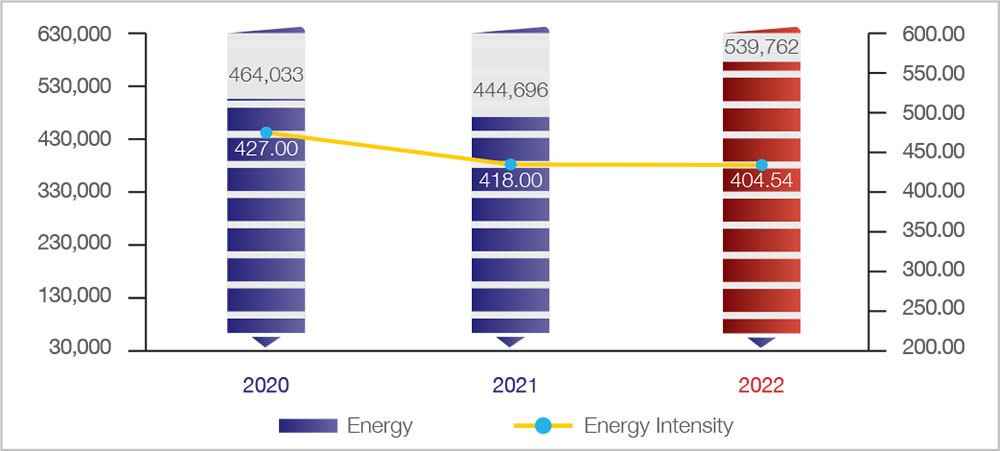
The Company operates two manufacturing facilities. Energy consumption data is recorded in relevant conventional unit, for instance, MMSCF for natural gas and kW h for electricity. These units are converted into consolidated unit, gigajoules (GJ), to obtain mean energy content and as a standard measure for representing energy consumption. The heating values are based upon standard values for natural gas and diesel. The energy consumption and sources in this report have been determined from data provided by production sites of Company and present a consolidated picture of Company’s energy consumption in manufacturing operations.
GHG Emissions
The Company’s products are in compliance with requirements of Pakistan Standards for Quality Control Authority (PSQCA) in respect of CO2 emissions, noise levels and smoke. Further, all products of the Company comply with EURO II standards of carbon emission. The emissions of GHGs are subject to control limits laid down by Environmental Protection Agency and the Company ensures compliance with these limits by determining total emissions for each plant site at regular intervals and is moving further to reduce the emissions up to maximum possible limit.
The direct CO2 emissions are the result of combustion processes for the generation of heat electricity and steam. Emissions of CO2 and other GHG are measured at each production facility and integrated into consolidated calculation of GHG emissions. The GHG figures only include the emissions caused by the Company. The global warming potential of the respective gaseous emissions was sourced from United Nations Framework Convention on Climate change (UNFCC).
The Company has no biogenic emission of CO2 at its operations. All the emissions are within the prescribed NEQS limits and regularly reported to the EPA under SMART reporting program. Furthermore, the Company does not have any significant Scope-II emissions. The only scope-II emissions result from purchased electricity at marketing offices and warranty centers of the Company and these are considered to be insignificant. Moreover, the Company identified that scope-III emissions are insignificant in the overall context except the emissions resulting from products transportation and selling. The Company is working with the transporters to apprise them of the emissions, effects of climate change and encourage them to upgrade their fleets to reduce emissions
The emissions during the year were 28,195 tons mainly comprising of CO2. The Company uses previous year as base year. The emissions were higher as compared to last year on account of increase in number of units produced. However, emissions per bike have been brought down to 21.12 kg / motorcycle: 2% reduction from 2021. Furthermore, the information includes the emissions that are directly generated by the Company.
There were no significant emissions of ozone-depleting substances during the year. The company is committed to the non-use of ozone-depleting substances as a part of its environmental management policy. The company is in process of replacing its old air conditioners with air conditioners which use R410 gas and do not harm the ozone layer.
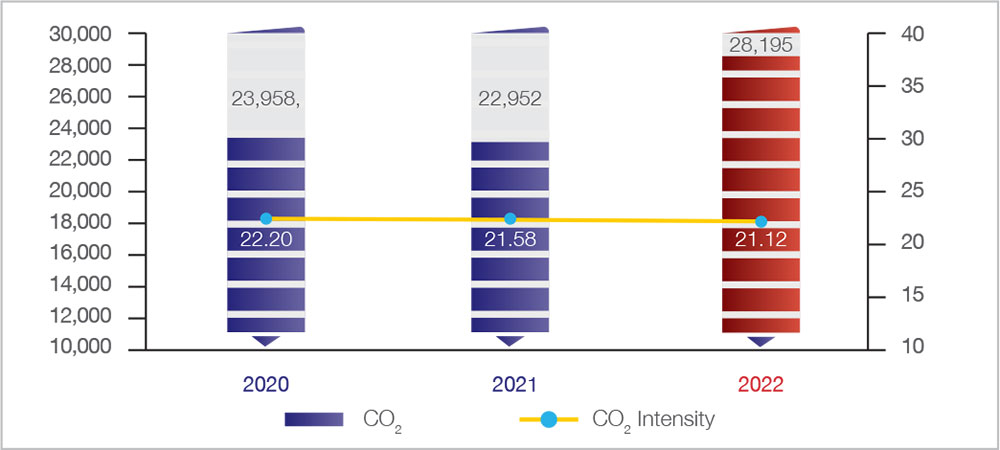
 Energy Conservation and Emission Reduction Initiatives
Energy Conservation and Emission Reduction Initiatives
Lack of access to energy supplies and transformation systems is a constraint to human and economic development. Increased use of fossil fuels without actions to mitigate greenhouse gases will have climate change implications. Energy efficiency and increase use of renewables contribute to climate change mitigation and disaster risk reduction. To reduce the Company’s energy consumption and emissions, primarily CO2 , investments have been made and energy efficiency measures have been implemented at the Company’s offices and production facilities. During the year, energy conservation of 18,358 GJ and emission reduction of 2,361 tons was achieved through following initiatives:
Solar Panels
The Company is determined to extend its use of renewable sources for energy. Installation of solar power systems is one of the major projects under the efforts in this area. This is aimed to derive clean & affordable energy to reduce greenhouse gas emissions and Atlas Honda’s dependence on fossil fuel or grid-based electricity. This year, the Company increased solar energy utilization from 3,581 to 3,955 KW during the year. This initiative will help to save 14,243 GJ of energy and reduce CO2 emissions by 1,859 tons every year.
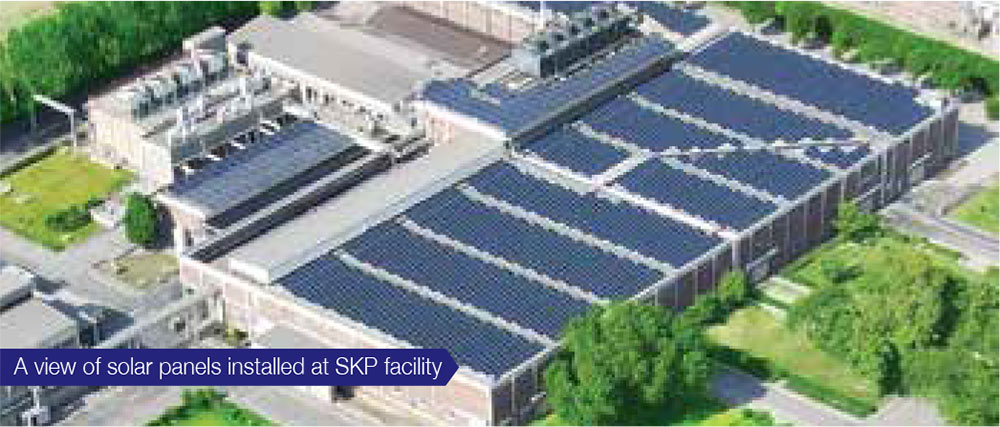
Installation of Variable Frequency Drives (VFDs) on Plant & Machinery
VFD is a type of motor controller that drives an electric motor by varying the frequency and voltage of its power supply. During the year, VFDs were installed at four press machines and two compressors having motor rating 160 KW and 200 KW. Installation of VFDs reduced the energy consumption of these machines by 38%, which resulted in reduction in energy consumption by 3,504 GJ per annum and reduction in CO2 by 414 Tons per annum.
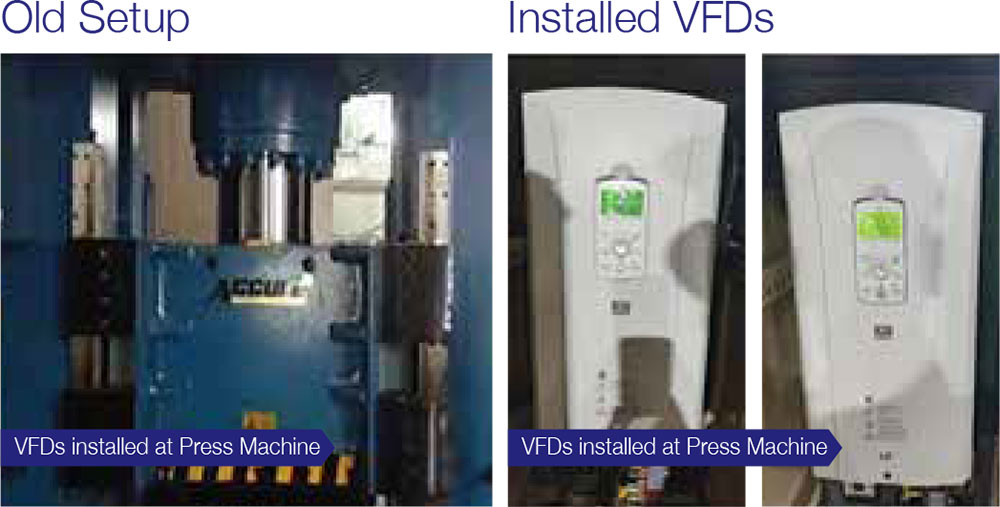
Electricity saving by sparing the Circulation Pump (ED Paint)
Previously two motor pumps each of 15KW capacity were running to operate heat exchangers, resulting in high electricity consumption. The heat exchanger is modified, and plates are replaced to improve its efficiency. After this modification only one motor is enough to operate heat exchanger and other pump is in standby condition. This has reduced energy consumption by 60 GJ per annum and has reduced CO2 emissions by 7 tons per annum.
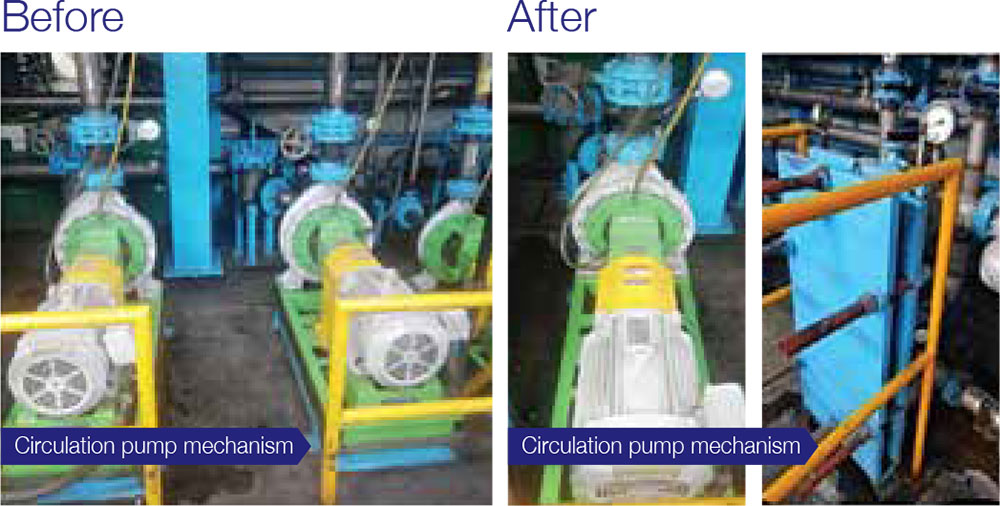
Energy Conservation on Cooling Tower
Previously chilled water was used in furnaces in one of the manufacturing areas of Company, throughout the year. The Company during the year optimized electricity consumption by using weather effect of winter season to cool the water required in production area. This eliminated the need to operate cooling tower fan for 3 months during a year, which resulted in reduction in energy consumption by 84 GJ and reduction in reduced CO2 emissions by 10 tons, per annum.
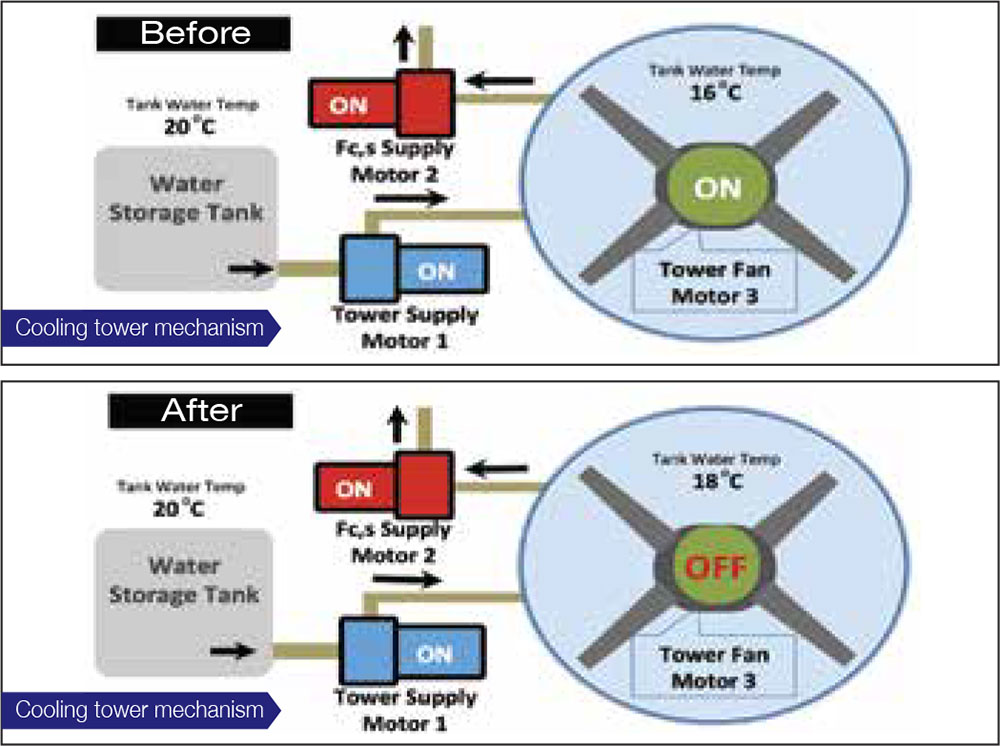
Installation of LDR on Shop Lights to Maximize utilization of Sky Light.
Company has started to use natural skylight along with LED lights at its newly constructed production areas. This has resulted in reduction in energy consumption by 168 GJ and reduction in CO2 emissions by 20 tons during the year.
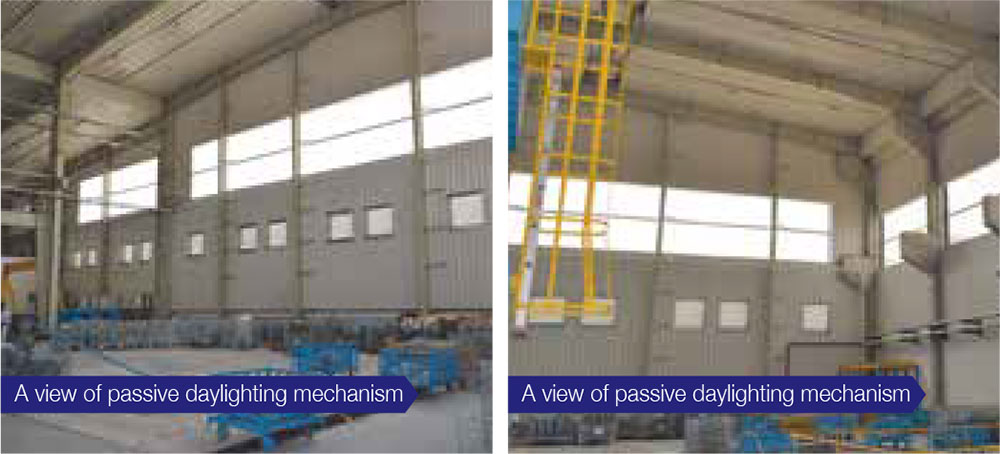
Electricity Saving through Process Optimization
Ultra-Filtration in paint shops is done by three UF pumps and to retain process parameters in required range, three pumps remain operational 24/7. However, during the current year research has been undertaken and these pumps are kept switched off every hour during non-operational time. This has resulted in reduction in energy consumption by 133 GJ and reduction in CO2 emissions by 22.5 tons during the year.
Auto Shut Off Valve in Compressed Air Line to Save Energy During Idle Hours.
Auto shut off valves are installed at compressed air line to save energy during idle production hours. This has resulted in reduction in energy consumption by 165 GJ and reduction in CO2 emissions by 28 tons during the year
Installation of Chip & Sludge Removal
Previously, the coolants used in Company’s machines were discarded as Sludge and contaminated oil render it infeasible for recycling. During the year the Company has installed Coolant purification system which has maximized recycling of coolants used in the Company’s machines. This recycling has reduced the consumption of coolants by 4,900 liters per annum. This will further reduce the disposal of hazardous waste.
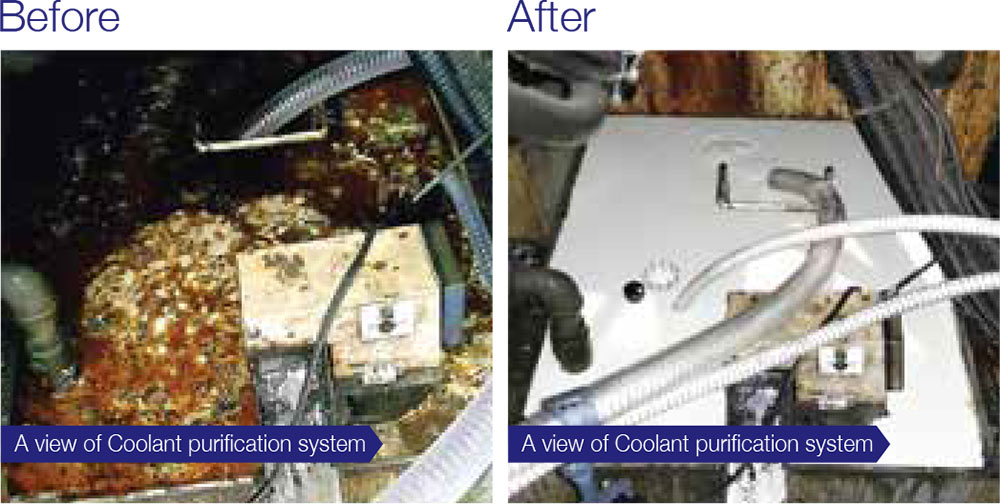
 Material, Effluents & Waste
Material, Effluents & Waste
To ensure sustainable consumption and production practices necessary to respect the biophysical boundaries of the planet and to reduce current consumption rates in order to fit with the biophysical capacity to produce ecosystem services and benefits. At Atlas Honda, environmental friendly use of raw materials is taken into account as early as the development phase through life cycle engineering. The Company’s supply chain and material cycles have been shaped accordingly. Natural resources are being used in the most efficient manner with the objective to minimize depletion of the planet’s resources. The Company is working to replace artificial materials with renewable materials wherever it makes technical, business and environmental sense and is socially viable. Consumption of raw materials, having substantial impact on the environment, is closely monitored and treated according to the Company’s environmental policy. Following table shows the materials used:
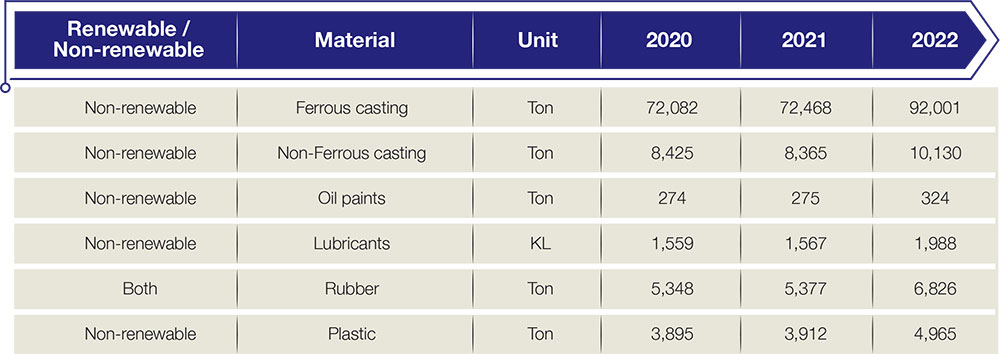
Waste resulting from the Company’s production processes mainly includes waste water, metal, plastic & rubber scrap, packing & used oil. Considering water-related environmental impacts from our discharged water, waste water is treated through Waste Water Treatment Plant before it is released in sewerage drains to control the negative impacts and promote a healthy environment. The remaining waste and effluents are discharged through incineration, recycling, landfill and disposal to legitimate contractors at certified waste disposal facilities. Company ensures that these contractors follow guidelines issued by regulatory authorities for safe disposal of the said waste.
During the year, 10,304 tons of waste was released with the reduced intensity of 9.3% per motorcycle. There were no significant spills during the year.

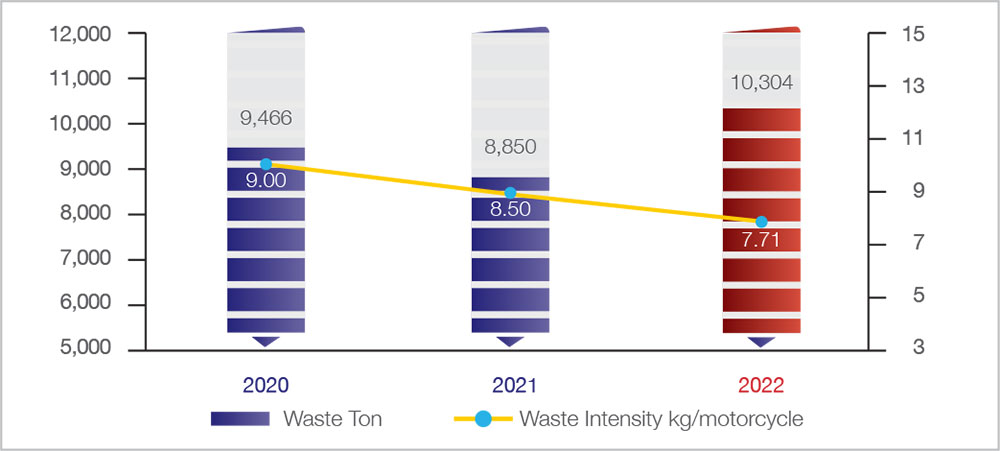
 Recycling, Waste Control and Waste Reductions Measures and Initiatives
Recycling, Waste Control and Waste Reductions Measures and Initiatives
During the year the Company took following initiatives at its production facilities and to reduce its material consumption and waste generations accordingly:
Reduction in Packaging waste
Previously, the Company used bubble plastic sheets for packaging of crank case parts which were non-recyclable. The Company has now replaced bubble plastic sheets with Vinyl Sheets with can be reused for up to 20 times within 6 months. This has resulted in wastage reduction of approximately 1.3 tons per annum.
Furthermore, the Company reduced its paper and card box waste by 135 tons.
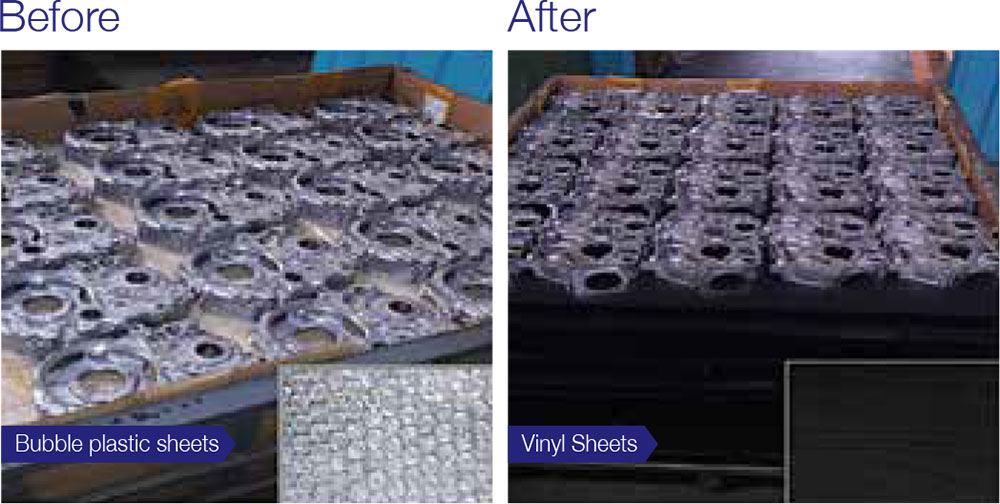
Recycling of Aluminum Waste
During the year the Company recycled 492 tons of aluminum waste which is generated as part of its various production processes. This represents 5% of total non-ferrous casting material consumed by the Company during the current year.
 Water
Water
The Company seeks to reduce its water footprint by promoting water-saving practices amongst employees and adopting water-efficient technologies and equipment wherever possible. Sustainable management of water resources and access to safe water and sanitation are essential for unlocking economic growth and productivity, and provide significant leverage for existing investments in health and education. The natural environment e.g. forests, soils and wetlands contribute to management and regulation of water availability and water quality. The Company has special focus on this goal and clean drinking water and sanitation facilities are ensured at all business offices. The majority of the Company’s water use is attributable to its production processes, cooling and water consumed by employees. Main areas of action are thoughtful use and reuse of water and safe disposal of treated wastewater. Significant proportion of the water consumed is fresh water, drawn from earth which is not designated as a protected area and no protected species are affected by water extraction, whereas the size or volume of the water body cannot be estimated reliably.
Water consumption and discharge is recorded through flow meters installed at water tanks and treatment plant, respectively. During the year, 713,878 cubic meters of water was consumed with a reduced intensity of 3% per vehicle as compared to the last year. After proper treatment, water used in manufacturing process is released back to environment. Such treatment removes pollutants from the water and makes the same suitable for safe drainage. No water bodies or related habitats were significantly affected by water discharges of the Company as these areas are not designated as protected areas.
During the year, 107,082 cubic meters (15%) of the water was recycled.
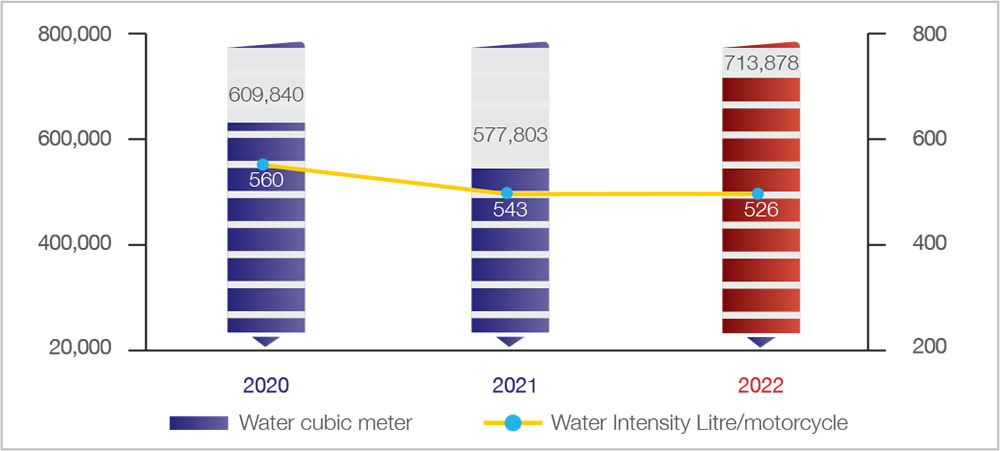
 Waste Water Treatment Plant
Waste Water Treatment Plant
Water is used throughout the Company’s production processes which results in wastewater. To prevent the wastewater from being discharged as produced, waste water from all over the plant is collected and treated to remove the harmful pollutants, at two Waste Water Treatment Plants at manufacturing sites of the Company. The profile of the receiving waterbody is however, not considered due to safe drainage after treatment. The Company, as a responsible organization abides by the legal requirements of waste water treatment as well as meets “Punjab Environmental Quality Standards”. This year, around 606,796 cubic meter of water was treated and safely drained into the sewerage.
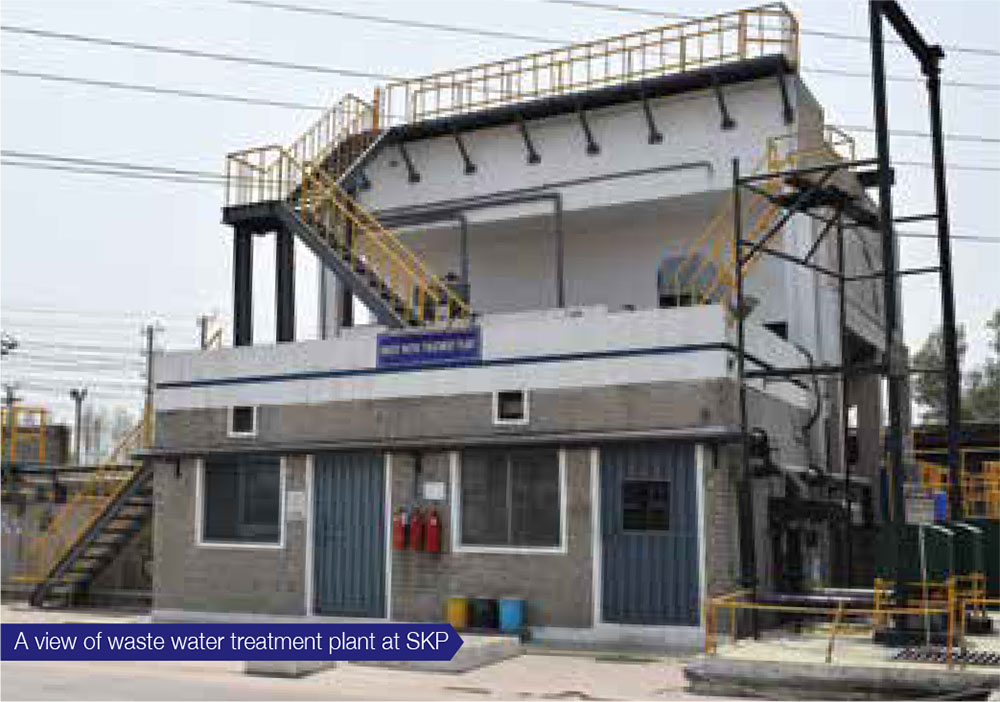
Water Saving in Paint Shops
Water tank of paint shops of the Company, with capacity 44,000 liters was cleaned every week. The Company during the year modified its manufacturing process such that the water tank needs to be cleaned up after two weeks. This initiative reduced the consumption of water by 144 cubic meters, greasing material by 1.15 tons, spray booth additives by 6.3 ton, and diesel by 520 liters, annually.
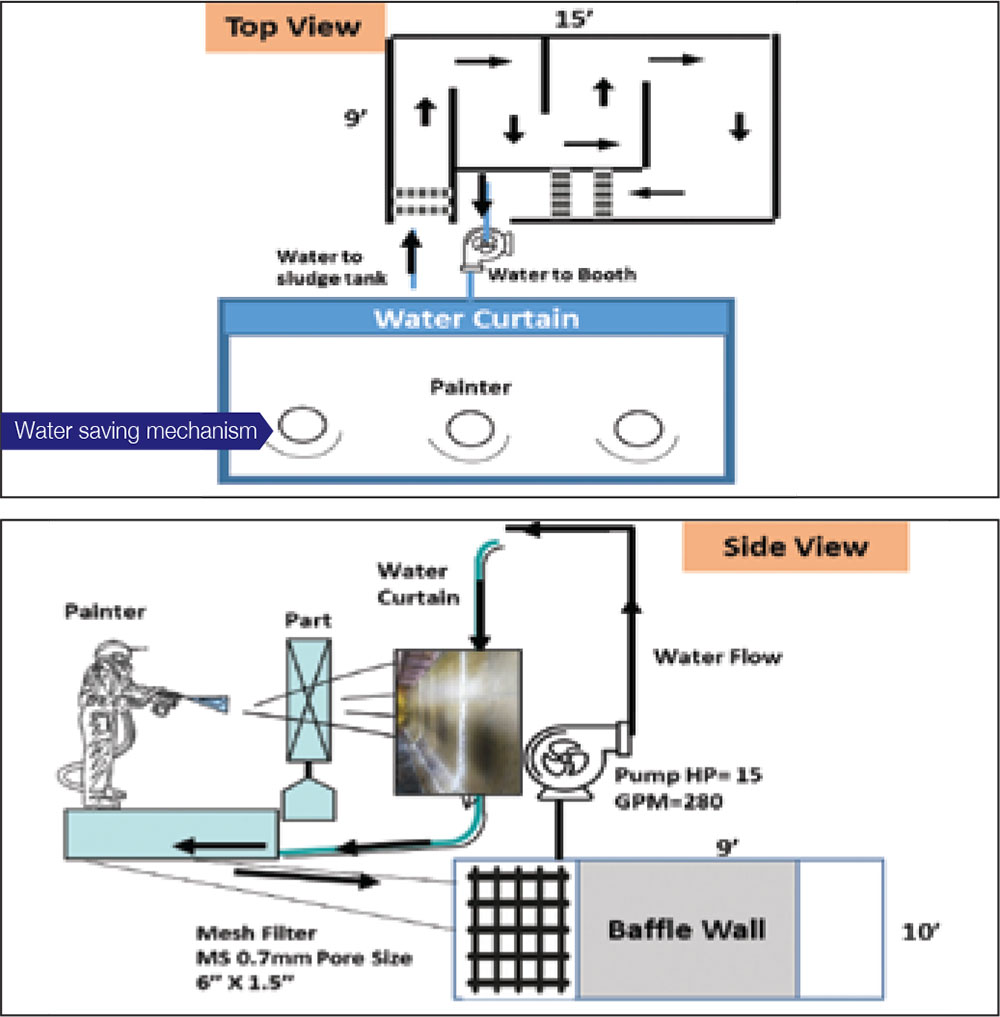
Recycling of Water Treated through Waste Water Treatment Plant (WWTP)
Company during the current year started using recycled water which is treated through waste water treatment plant at three different locations of its manufacturing facilities. This resulted in reduction of water consumption by 11,155 cubic meters annually and reduced the annual drainage of water by the same volume.
 Biodiversity
Biodiversity
The Company has clear vision from the onset of its business related to environment protection, therefore both of the manufacturing plants have been located away from protected areas to minimize the effects of CO2 and greenhouse gases on the protected areas.
With reference to the Environment statement, the Company considers biodiversity conservation initiatives as imperative part of its commitment to the preservation of the environment. The Company will work incessantly towards the harmony between the commitment and its activities. Following are the broad guidelines related to biodiversity:
- Company will continue to channelize efforts towards the development of technologies for fuel-efficient vehicles and other technologies for the reduction of environmental impacts;
- Environmental impacts will be minimized by the effective use of resources through efficiency improvements;
- Community-based activities will be implemented in cooperation with stakeholders; and
- Company will promote transparency of information related to the outcomes of its activities.

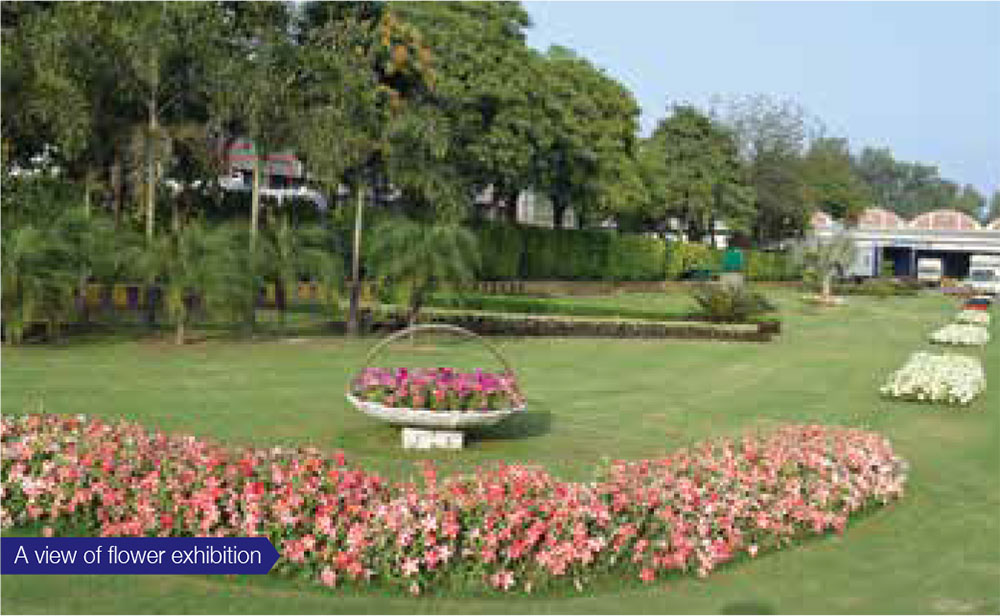
During the year the Company was awarded 1st prize for 163rd Annual Spring Flower Show 2022 by Horticultural Society of Pakistan.
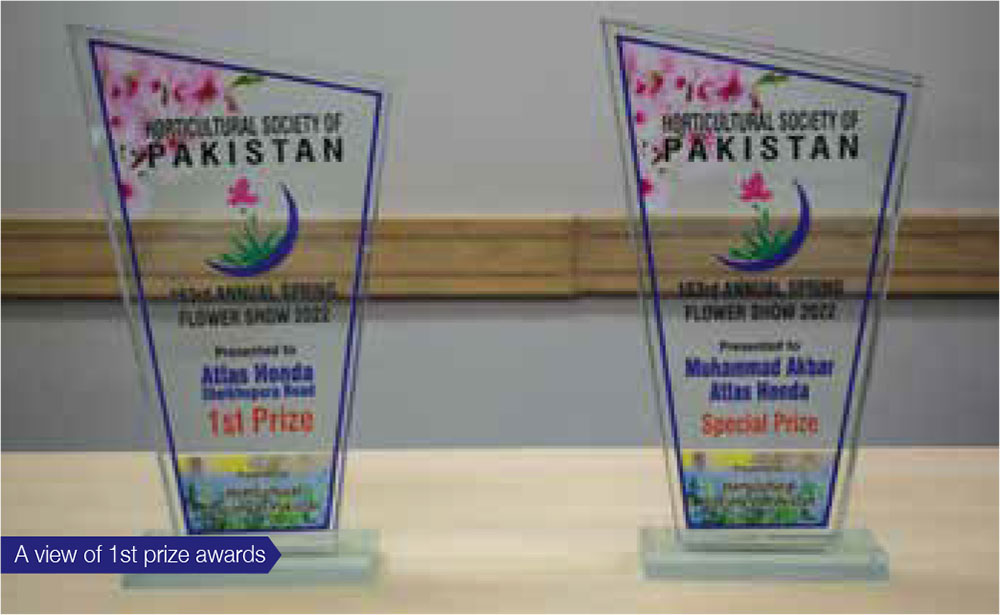
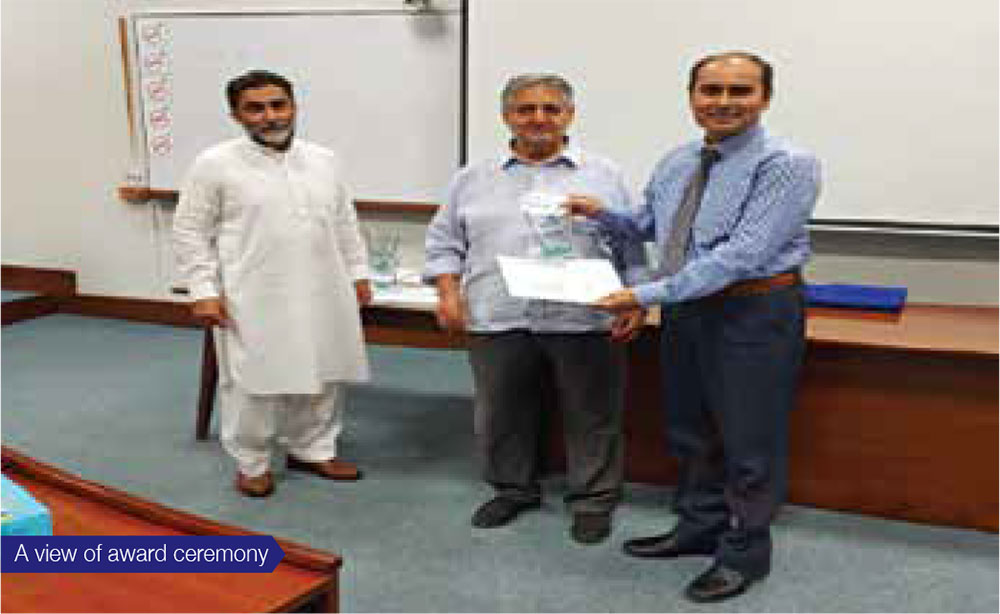
 Plantation of Trees
Plantation of Trees
Over the years, the Company has been undertaking initiatives such as tree plantation to negate the impact of greenhouses gases. These activities cover in-house plantation of trees as well as those planted at schools, government institutes and reservoirs in collaboration with Environmental Protection Agency. During the year, 2,897 trees were planted and 7,500 trees were planted in collaboration with the Government departments.

Environmental Protection
Management Approach
Environmental protection is fundamental to the Company’s sustainability strategy. In view of challenges such as climate change, pollution and scarcity of resources, Atlas Honda aims to be the most resource-efficient mobility solution provider in Pakistan. The Company’s focus lies on increasing the energy and resource efficiency of its production processes and on reducing emissions and waste. These measures allow the Company to minimize impacts on the environment, make a contribution towards achievement of Honda’s environmental vision and reduce costs. Environment related issues arising from energy & resource consumption, emissions, effluents & waste and water are managed by the Company’s Production & HSE departments in coordination with other departments. Necessary procedures are defined and implemented to achieve targets. The Company has a continuously evolving Environmental Management System (EMS) in place which is supported by the Company’s Environmental Policy to ensure effectiveness of processes, monitoring and continual improvement in the Company’s environmental performance.
Green practices are being implemented at all locations of the Company and those of its business partners. Awareness is being raised by the Company through continuous training and development programs for its suppliers as well as employees. In recognition of its efforts for protection of environment, the Company has been presented with Awards by National Forum for Environment & Health (NFEH), for the year 2020, in the category of Environment & Waste Management.
Environmental Policy
The Company’s Environmental Policy covers every aspect of the Company’s operations, whether they are directly or indirectly related to designing, engineering, manufacturing, distribution and service:

Environment Management System (EMS)
EMS is intended to formalize procedures for managing and reducing environmental footprint. It helps the Company organize and analyse, in a timely manner, the environmental impacts that result from its business operations. It also helps the Company in developing solutions to address those impacts. The Company’s EMS is based on relevant legislation such as the Pakistan Environmental Protection Law, international standards and Honda’s guidelines, as well as best practices. The management system is certified in accordance with ISO 14001:2015, an international certification for EMS.
The Company conducts internal and external audits of its EMS and strives for further improvement. During the year, the Company identified tasks as a result of in-house reviews and made improvements accordingly. Periodic visits by representatives from Environmental Protection Agency (EPA) are also facilitated to ensure compliance with regulatory requirements.
No non-compliances have been reported during the year. Further, no environment-related complaints were received through the Company’s formal grievance mechanism during the reporting period.
Life Cycle Assessment
The Company applies a product life cycle approach for management of environmental impacts, which considers the entire life cycle – from product development to purchasing, manufacturing, sales & service, use, recycling and administration. This approach makes it easier to identify opportunities, minimize or enhance impacts and understand boundaries in every aspect of the Company’s business. It also helps the Company understand how its actions and impacts are interrelated. The Company also applies the precautionary principle, whereby it acts responsibly despite not having the full scientific knowledge of negative impacts, to ensure the Company stays ahead of potential risks.

Energy Consumption and Emissions
The Company monitors energy consumption and emissions on regular basis to identify and incorporate best practices and to improve the Company’s energy management. Both the Company’s manufacturing plants are located away from protected areas to minimize the effects of CO2 and other greenhouse gases on such areas. The Company’s primary sources of energy are grid based electricity, natural gas and diesel. Other sources include solar energy. However, currently only a small part of the total energy is being derived from solar panels. The Company is making efforts to increase the share of renewable sources of energy. Accurate data on energy consumption and emissions is obtained from management systems. The conversion factors are sourced from U.S. Energy Information Administration. The Company uses previous year as base year to measure energy consumption and emissions. This enables the Company to address irregularities and implement necessary measures to ensure the Company’s performance is on track. Collecting comprehensive data helps in understanding not only the energy savings, but also the economic benefits that can be achieved through specific measures.
The energy consumption during the year was 444,696 GJ. Compared to 2020, the total energy consumption during the year under review decreased by 4.2% on account of new energy initiatives adopted as part of our green practices. The energy consumption per motorcycle has been brought down to 418 KJ/Motorcycle.

The Company’s products are in compliance with requirements of Pakistan Standards for Quality Control Authority (PSQCA) in respect of CO2 emissions, noise levels and smoke. Further, all products of the Company comply with EURO II standards of carbon emission. The emissions during the year were 22,952 tons mainly comprising of CO2. Emissions per bike have been brought down to 21.58 kg/motorcycle.

 Energy Conservation and Emission Reduction Initiatives
Energy Conservation and Emission Reduction Initiatives
Lack of access to energy supplies and transformation systems is a constraint to human and economic development. Increased use of fossil fuels without actions to mitigate greenhouse gases will have climate change implications. Energy efficiency and increase use of renewables contribute to climate change mitigation and disaster risk reduction. To reduce the Company’s energy consumption and emissions, primarily CO2 , investments have been made and energy efficiency measures have been implemented at the Company’s offices and production facilities. During the year, energy conservation of 13,935 GJ and emission reduction of 1,784 tons was achieved through following initiatives:
Solar Panels
The Company is determined to extend its use of renewable sources for energy. Installation of solar power systems is one of the major projects under the efforts in this area. This is aimed to derive clean & affordable energy to reduce greenhouse gas emissions and Atlas Honda’s dependence on fossil fuel or grid-based electricity. This year, the Company increased solar energy utilization from 1,398 KW to 3,581 KW at Sheikhupura plant. This initiative will help to save 12,890 GJ of energy and reduce CO2 emissions by 1,652 tons every year.

Installation of Alternate Mechanism for Parts & Jigs Cleaning
Previously, parts and jigs of engine plant were cleaned using compressed air at 5 Bar. Cleaning of parts through compressed air involves wastage of 10% to 12% air owing to leakages in air cleaning guns. Cleaning through compressed air is replaced by cleaning through cutting oil guns. This energy conservative initiative has resulted in reduction in energy consumption by 438 GJ per annum and reduction in CO2 emission by 55 Tons.
Old Setup


New Setup

Shutting off Cooling Water Pump
Previously, two pumps each of 1.5 KW were being used continuously to maintain the temperature of water base paint. During the year, the Company has modified piping mechanism, running the chilled water through ED paint heat exchanger which has eliminated the requirement of second water pump. This has reduced the energy consumption by 54 GJ and CO2 emission by 7 tons per annum.
Old Setup

New Setup

Energy Conservation on Cooling Tower
Previously, cooling tower was used throughout the year to cool off water storage tank for use in engine plant. During the year the Company has optimized the electricity consumption by utilizing weather effect of winter season to cool the water required in the production area. This measure has reduced the electricity consumption by 41 GJ and CO2 emission by 5 tons per annum.
Alternate Mechanism for Water Heating at Machining Area
The parts processed in the machining area contains aluminium and oil particles, which require washing using heated water. Previously, heaters were used for the purpose. During the year, an alternate mechanism has been implemented, heating the water in winter season by using the waste heat recovery steam, generated from gas generators exhaust system. This measure helped to reduce the electricity consumption by 97 GJ and CO2 emission by 12 tons during the year.
Old Setup

New Setup

Alternate Mechanism for HVAC System of Welding Frame Body Line
Exhaust and fresh air blowers are used for ventilation purpose at frame body welding line. However, Fresh air and exhaust ducts are Common for both CG models and Pridor model production lines. In G2 Pridor is not produced but air supply and exhaust systems remain in operations. Exhaust and air supply system has been re-designed, by installing motorized damper at each line to control air wastages in G2. This enables us to shut down 60 KW of blower when the related production line is idle. This measure has resulted in reduction of electricity consumption by 415 GJ and CO2 emission by 53 tons during the year.

Tuning of Synthetic Natural Gas (SNG Plant)
Previously, the mix ratio of LPG and air at the SNG plant was not at optimum level resulting in incomplete burning and heat loss. During the year, the composition of LPG and air in the SNG mix is modified to achieve environment friendly results. This will reduce the LPG consumption from 14,000 litres per day to 13,720 litres per day.

 Plantation of Trees
Plantation of Trees
Over the years, the Company has been undertaking initiatives such as tree plantation to negate the impact of greenhouses gases. These activities cover in-house plantation of trees as well as those planted at schools, government institutes and reservoirs in collaboration with Environmental Protection Agency. During the year, 2,370 trees were planted and 5,000 trees were distributed to the Government departments. The Company also received awards from Punjab Horticulture Society for Horticulture, Landscaping and Gardening.

 Material, Effluents & Waste
Material, Effluents & Waste
To ensure sustainable consumption and production practices necessarily entails to respect the biophysical boundaries of the planet and to reduce current consumption rates in order to fit with the biophysical capacity to produce ecosystem services and benefits. At Atlas Honda, environmental friendly use of raw materials is taken into account as early as the development phase through life cycle engineering. The Company’s supply chain and material cycles have been shaped accordingly. Natural resources are being used in the most efficient manner with the objective to minimize depletion of the planet’s resources. The Company is working to replace artificial materials with renewable materials wherever it makes technical, business and environmental sense and is socially viable. Consumption of raw materials, having substantial impact on the environment, is closely monitored and treated according to the Company’s environment policy.
Following table shows the materials used:

Waste resulting from the Company’s production processes mainly includes waste water, metal, plastic & rubber scrap, packing & used oil. Considering water-related environmental impacts from our discharged water, waste water is treated through Waste Water Treatment Plant before it is released in sewerage drains to control the negative impacts and promote a healthy environment. The remaining waste and effluents are discharged through incineration, recycling, landfill and disposal to legitimate contractors at certified waste disposal facilities. During the year, 8,850 tons of waste was released with the reduced intensity of 8.5% per motorcycle. There were no significant spills during the year.


 Water
Water
The Company seeks to reduce its water footprint by promoting water-saving practices amongst employees and adopting water-efficient technologies and equipment wherever possible. Sustainable management of water resources and access to safe water and sanitation are essential for clean environment and productivity, and provide significant leverage for existing investments in health and education. The natural environment e.g. forests, soils and wetlands contribute to management and regulation of water availability and water quality. The Company has special focus on this goal and clean drinking water and sanitation facilities are ensured at all the business offices.
The majority of the Company’s water use is attributable to its production processes, cooling and water consumed by employees. Main areas of action are thoughtful use and reuse of water and safe disposal of treated waste-water. Most of the water consumed is fresh water, drawn from earth which is not designated as a protected area whereas the size or volume of the water body cannot be estimated reliably.
Water consumption and discharge is recorded through flow meters installed at water tanks and treatment plant, respectively. During the year, 577,803 cubic meters of water was consumed with a reduced intensity of 3% per vehicle as compared to the last year. After proper treatment, water used in manufacturing process is released back to environment. Such treatment removes pollutants from the water and makes the same suitable for safe drainage. During the year, 86,671 cubic meters (15%) of the water was recycled.

 Effluent Water Treatment Plant
Effluent Water Treatment Plant
Water is used throughout the Company’s production processes which results in effluent water. To prevent the effluent water from being discharged as produced, waste water from all over the plant is collected and treated to remove the harmful pollutants, at Effluent Water Treatment Plant. The profile of the receiving water-body is however not considered due to safe drainage after treatment. The Company, as a responsible organization abides by the legal requirements of effluent water treatment as well as meets “Provincial Environment Quality Standards”. This year, around 506,233 cubic meter of water was treated and safely drained into the sewerage.

Water Recycling & Pretreatment at Drainage
Previously, 12,000 liters of water was drained every three months through drain tank when alkali water tank and hot water tanks were cleaned. Furthermore, cleaning process required 144 KG of chemicals. During the year, the Company has modified its water piping process and converted the drain tank into storage tank which has resulted in recycling of 45,000 liters of water per annum.

 Biodiversity
Biodiversity
The Company has clear vision from the onset of its business related to environment protection, therefore both of the manufacturing plants have been located away from protected areas to minimize the effects of CO2 and greenhouse gases on the protected areas.
With reference to the Environment statement, the Company considers biodiversity conservation initiatives as imperative part of our commitment to the preservation of the environment. The Company will work incessantly towards the harmony between the commitment and its activities.
Following are the broad guidelines related to biodiversity:
- Company will continue to channelize efforts towards the development of technologies for fuel-efficient vehicles and other technologies for the reduction of environmental impacts;
- Environmental impacts will be minimized by the effective use of resources through efficiency improvements;
- Community-based activities will be implemented in cooperation with stakeholders; and
- Company will promote transparency of information related to the outcomes of its activities.


Environmental Protection
Management Approach
Environmental protection is fundamental to the Company’s sustainability strategy. In view of challenges such as climate change, pollution and scarcity of resources, Atlas Honda aims to be the most resource-efficient mobility solution provider in Pakistan. The Company’s focus lies on increasing the energy and resource efficiency of its production processes and on reducing emissions and waste. These measures allow the Company to minimize impacts on the environment, make a contribution towards achievement of Honda’s environmental vision and reduce costs. Environment related issues arising from energy & resource consumption, emissions, effluents & waste and water are managed by the Company’s Production & HSE departments in coordination with other departments. Necessary procedures are defined and implemented to achieve targets. The Company has a continuously evolving Environmental Management System (EMS) in place which is supported by the Company’s Environmental Policy to ensure effectiveness of processes, monitoring and continual improvement in the Company’s environmental performance.
Green practices are being implemented at all locations of the Company and those of its business partners. Awareness is being raised by the Company through continuous training and development programs for its suppliers as well as employees. In recognition of its efforts for protection of environment, the Company has been presented with Awards by National Forum for Environment & Health (NFEH), for the year 2019, in the category of Environment & Waste Management.
Environmental Policy
The Company’s Environmental Policy covers every aspect of the Company’s operations, whether they are directly or indirectly related to designing, engineering, manufacturing, distribution or service:

Environment Management System
EMS is intended to formalize procedures for managing and reducing environmental footprint. It helps the Company organize and analyze, in a timely manner, the environmental impacts that result from its business operations. It also helps the Company in developing solutions to address those impacts.
The Company’s EMS is based on relevant legislation such as the Pakistan Environmental Protection Law, international standards and Honda’s guidelines, as well as best practices. The management system is certified in accordance with ISO 14001:2015, an international certification for EMS.
The Company conducts internal and external audits of its EMS and strives for further improvement. During the year, the Company identified tasks as a result of in-house reviews and made improvements accordingly. Periodic visits by representatives from Environmental Protection Agency (EPA) are also facilitated to ensure compliance with regulatory requirements.
No non-compliances have been reported during the year. Further, no environment-related complaints were received through the Company’s formal grievance mechanism during the reporting period.
Life Cycle Assessment
The Company applies a product life cycle approach for management of environmental impacts, which considers the entire life cycle – from product development to purchasing, manufacturing, sales & service, use, recycling and administration. This approach makes it easier to identify opportunities, minimize or enhance impacts and understand boundaries in every aspect of the Company’s business. It also helps the Company understand how its actions and impacts are interrelated. The Company also applies the precautionary principle, whereby it acts responsibly despite not having the full scientific knowledge of negative impacts, to ensure the Company stays ahead of potential risks.

Energy Consumption and Emissions
The Company monitors energy consumption and emissions on regular basis to identify and incorporate best practices and to improve the Company’s energy management. Both the Company’s manufacturing plants are located away from protected areas to minimize the effects of CO2 and other greenhouse gases on such areas. The Company’s primary sources of energy are grid based electricity, natural gas and diesel. Other sources include solar energy. However, currently only a small part of the total energy is being derived from solar panels. The Company is making efforts to increase the share of renewable sources of energy.
Accurate data on energy consumption and emissions is obtained from management systems. The conversion factors are sourced from U.S. Energy Information Administration. The Company uses previous year as base year to measure energy consumption and emissions. This enables the Company to address irregularities and implement necessary measures to ensure the Company’s performance is on track. Collecting comprehensive data helps in understanding not only the energy savings, but also the economic benefits that can be achieved through specific measures.
The energy consumption during the year was 464,033 GJ. Compared to 2019, the total energy consumption during the year under review decreased by 6.4% on account of lower production levels and new initiatives adopted as part of our green practices. The energy consumption per motorcycle has been brought down to 427 KJ/Motorcycle.

The Company’s products are in compliance with requirements of Pakistan Standards for Quality Control Authority (PSQCA) in respect of CO2 emissions, noise levels and smoke. Further, all products of the Company comply with EURO II standards of carbon emission. The emissions during the year were 23,958 tons mainly comprising of CO2. Emissions per bike have been brought down to 22.20 kg/motorcycle.

 Energy Conservation and Emission Reduction Initiatives
Energy Conservation and Emission Reduction Initiatives
Lack of access to energy supplies and transformation systems is a constraint to human and economic development. Increased use of fossil fuels without actions to mitigate greenhouse gases will have climate change implications. Energy efficiency and increase use of renewables contribute to climate change mitigation and disaster risk reduction. To reduce the Company’s energy consumption and emissions, primarily CO2, investments have been made and energy efficiency measures have been implemented at the Company’s offices and production facilities. During the year, energy conservation of 6,552 GJ and emission reduction of 826 tons was achieved through following initiatives:
Solar Panels
The Company is determined to extend its use of renewable sources for energy. Installation of solar power systems is one of the major projects under the efforts in this area. This is aimed to derive clean & affordable energy to reduce greenhouse gas emissions and Atlas Honda’s dependence on fossil fuel or grid-based electricity. This year, the Company increased solar energy utilization from 360 KW to 1,398 KW at Sheikhupura plant. This initiative will help to save 5,032 GJ of energy and reduce CO2 emissions by 645 tons every year.

LED Lights
As part of the Company’s project of replacing fluorescent tube lights and mercury bulbs with LED lights, this year, lights at gas power house, security gates and walkways of engine plant were replaced in addition to arrangements to use day light wherever possible. This has helped the Company in saving 552 GJ of energy and reducing 70 tons of CO2 in a year.
Installation of Light Dependent Resisters
To save energy, LDRs have been connected to lights at streets and boundary walls which regulate and automatically turn off the lights during daytime. This is helping the Company to save 219.5 GJ of energy and reduce 28.2 tons of CO2 per annum.


Installation of Air Boosters
Previously, for engine plant, compressors were operating at 6.8 bar pressure as against the requirement of 6.2 bar pressure for all machines except Coordinate Measuring Machine (CMM). Now, after installation of air booster into the line of CMM, compressors are being operated at 6.2 bar pressure. This initiative has resulted in reduction of 32 tons of CO2 per year.

Installation of Variable Frequency Drive
Previously, air blowers were operating at full capacity of 43 KW at 50 HZ. Since, air blowing requirement varies based on weather, temperature, working hours, etc., considering the variation in requirements, variable frequency drive has been installed. Now, air blower can be operated at variable capacity from 35 HZ to 45 HZ as per the requirement. This measure has reduced 9 tons of CO2 during the year.

Installation of Inverter Mig Welding
Previously, conventional mig welding plants were being used at the welding shop of Sheihkhupura plant. During the year, the Company upgraded to inverter mig welding plants which are more energy efficient. This helped in saving 63 GJ of energy and reduced 8 ton CO2 emissions.


Optimization of Cooling Power Plants
The Company has two cooling plants at die casting section. The Company has achieved optimization of the cooling efficiency of one of the cooling plants. This optimization has enabled the Company to operate only one plant, while meeting the requirements of all die casting shops. Saving through this measure is 685 GJ of energy and reduction of 34 tons of CO2 per year.

 Plantation of Trees
Plantation of Trees
Over the years, the Company has been undertaking initiatives such as tree plantation to negate the impact of greenhouses gases. These activities cover in-house plantation of trees as well as those planted at schools, government institutes and reservoirs in collaboration with Environmental Protection Agency. During the year, 16,100 trees were planted. The Company also received awards from Punjab Horticulture Society for Horticulture, Landscaping and Gardening.

 Materials, Effluents & Waste
Materials, Effluents & Waste
To ensure sustainable consumption and production practices necessarily entails to respect the biophysical boundaries of the planet and to reduce current consumption rates in order to fit with the biophysical capacity to produce ecosystem services and benefits. At Atlas Honda, environmental friendly use of raw materials is taken into account as early as the development phase through life cycle engineering. The Company’s supply chain and material cycles have been shaped accordingly. Natural resources are being used in the most efficient manner with the objective to minimize depletion of the planet’s resources. The Company is working to replace artificial materials with renewable materials wherever it makes technical, business and environmental sense and is socially viable. Consumption of raw materials, having substantial impact on the environment, is closely monitored and treated according to the Company’s environment policy. Following table shows the materials used:

Waste resulting from the Company’s production processes mainly includes waste water, metal, plastic & rubber scrap, packing & used oil. Waste water is treated through Waste Water Treatment Plant before it is released in sewerage drains. The remaining waste and effluents are discharged through incineration, recycling, landfill and disposal to legitimate contractors at certified waste disposal facilities. During the year, 9,466 tons of waste was released with the reduced intensity of 8.8% per motorcycle. There were no significant spills during the year.


Packaging Wastage
Vendors deliver motorcycle chain case, wrapped in bubble paper. The Company has started reusing it by sending back the used bubble paper to vendor. Vendors reuse such paper to wrap the motorcycle chain case in subsequent deliveries. Wastage reduction through this initiative is 608 tons.

Reuse of Tools
Previously machine tools were scrapped at engine plant, after use. The Company has started to reuse these tools after re-grinding at tool grinding facility of the Company. Wastage has been reduced by 1,320 ton per annum.

 Water
Water
The Company seeks to reduce its water footprint by promoting water-saving practices amongst employees and adopting water-efficient technologies and equipment wherever possible. Sustainable management of water resources and access to safe water and sanitation are essential for unlocking economic growth and productivity, and provide significant leverage for existing investments in health and education. The natural environment e.g. forests, soils and wetlands contribute to management and regulation of water availability and water quality. The Company has special focus on this goal and clean drinking water and sanitation facilities are ensured at all the business offices. The majority of the Company’s water use is attributable to its production processes, cooling and water consumed by employees. Main areas of action are thoughtful use and reuse of water and safe disposal of treated wastewater. Most of the water consumed is drawn from earth which is not designated as a protected area whereas the size or volume of the water body cannot be estimated reliably.
Water consumption and discharge is recorded through flow meters installed at water tanks and treatment plant, respectively. During the year, 609,840 cubic meters of water was consumed with a reduced intensity of 4% per vehicle as compared to the last year. After proper treatment, water used in manufacturing process is released back to environment. Such treatment removes pollutants from the water and makes the same suitable for safe drainage. During the year, 83,440 cubic meters (14%) of the water was recycled.

 Waste Water Treatment Plant
Waste Water Treatment Plant
Water is used throughout the Company’s production processes which results in wastewater. To prevent the wastewater from being discharged as produced, waste water from all over the plant is collected and treated to remove the harmful pollutants, at Waste Water Treatment Plant. The Company, as a responsible organization abides by the legal requirements of waste water treatment as well as meets “Punjab Environmental Quality Standards”. This year, around 565,500 cubic meter of water was treated and safely drained into the sewerage.

Water Saving in Die Casting Machines
For cooling of die casting machines, water is supplied to dies through cooling tower and discharged into cooling tower tank through a blind common header. Blind common header, was unable to monitor the supply and discharge of water of each section which creates negative pressure, resultantly more water stayed stagnant and lesser circulated in the loop. The Company has replaced old water pipe header with new modified header for visual monitoring of each discharge points and water circulates in closed loop. 9,200 cubic meters water is annually saved through this measure.

 Biodiversity
Biodiversity
The Company has clear vision from the onset of its business related to environment protection, therefore both of the manufacturing plants have been located away from protected areas to minimize the effects of CO2 and greenhouse gases on the protected areas.
With reference to the Environment statement, the Company considers biodiversity conservation initiatives as imperative part of our commitment to the preservation of the environment. The Company will work incessantly towards the harmony between the commitment and its activities. Following are the broad guidelines related to biodiversity:
- Company will continue to channelize efforts towards the development of technologies for fuel-efficient vehicles and other technologies for the reduction of environmental impacts;
- Environmental impacts will be minimized by the effective use of resources through efficiency improvements;
- Community-based activities will be implemented in cooperation with stakeholders; and
- Company will promote transparency of information related to the outcomes of its activities.

Management Approach
Environmental protection is fundamental to the Company’s sustainability strategy. In view of challenges such as climate change, pollution and scarcity of resources, Atlas Honda aims to be the most resource-efficient mobility solution provider in Pakistan. The Company’s focus lies on increasing the energy and resource efficiency of its production processes and on reducing emissions and waste. These measures allow the Company to minimize impacts on the environment, make a contribution towards achievement of Honda’s Environmental Vision and reduce costs. Environment related issues arising from energy & resource consumption, emissions, effluents & waste and water are managed by the Company’s Production & HSE departments in coordination with other departments. Necessary procedures are defined and implemented to achieve targets. The Company has a continuously evolving Environmental Management System (EMS) in place which is supported by the Company’s Environmental Policy to ensure effectiveness of processes, monitoring and continual improvement in the Company’s environmental performance.
Green practices are being implemented at all locations of the Company and those of its business partners. Awareness is being raised by the Company through continuous training and development programs for its suppliers as well as employees. In recognition of its efforts for protection of environment, the Company has been presented with an Award by National Forum for Environment & Health (NFEH), for the year 2018, in the category of Environment & Waste Management.
Environmental Policy
The Company’s Environmental Policy covers every aspect of the Company’s operations, whether they are directly or indirectly related to design, engineering, manufacture, distribution and service:

Environment Management System
EMS is intended to formalize procedures for managing and reducing environmental footprint. It helps the Company organize and analyze, in a timely manner, the environmental impacts that result from its business operations. It also helps the Company in developing solutions to address those impacts.
The Company’s EMS is based on relevant legislation such as the Pakistan Environmental Protection Law, international standards and Honda’s guidelines, as well as best practices. The management system is certified in accordance with ISO 14001:2015, an international certification for EMS.
The Company conducts internal and external audits of its EMS and strives for further improvement. During the year, the Company identified tasks as a result of in-house reviews and made improvements accordingly. Periodic visits by representatives from Environmental Protection Agency (EPA) are also facilitated to ensure compliance with regulatory requirements.
No non-compliances have been reported during the year. Further, no environment-related complaints were received through the Company’s formal grievance mechanism during the reporting period.
Life Cycle Assessment
The Company’s applies a product lifecycle approach for management of environmental impacts, which considers the entire lifecycle – from product development to purchasing, manufacturing, sales & service, use, recycling and administration. This approach makes it easier to identify opportunities, minimize or enhance impacts and understand boundaries in every aspect of the Company’s business. It also helps the Company understand how its actions and impacts are interrelated. The Company also applies the precautionary principle, whereby it acts responsibly despite not having the full scientific knowledge of negative impacts, to ensure the Company stays ahead of potential risks.

Energy Consumption and Emissions
The Company monitors energy consumption and emissions on regular basis to identify and incorporate best practices and to improve the Company’s energy management. Both the Company’s manufacturing plants are located away from protected areas to minimize the effects of CO2 and other greenhouse gases on such areas. The Company’s primary sources of energy are grid based electricity, natural gas and diesel. Other sources include solar energy. However, currently only a small part of the total energy is being derived from solar panels. The Company is making efforts to increase the share of renewable sources of energy.
Accurate data on energy consumption and emissions is obtained from management systems. The conversion factors are sourced from U.S. Energy Information Administration. The Company uses previous year as base year to measure energy consumption and emissions. This enables the Company to address irregularities and implement necessary measures to ensure the Company’s performance is on track. Collecting comprehensive data helps in understanding not only the energy savings, but also the economic benefits that can be achieved through specific measures. This year, an energy audit was also conducted by an independent third party licensed by Association of Energy Engineers, USA. The objective of the audit was to understand the energy flows within the Company’s plant and to identify opportunities to reduce the amount of energy consumption.
The energy consumption during the year was 495,525 GJ. Compared to 2018, the total energy consumption during the year under review increased by 6.6% on account of higher production level. However, the energy consumption per motorcycle remained constant at 435 KJ/Motorcycle despite rise in energy prices.

The Company’s products are in compliance with Pakistan Standards for Quality Control (PSQC) in respect of CO2 emissions, noise levels and smoke. Further, all products of the Company comply with EURO II standards of carbon emission. The emissions during the year were 28,985 tons mainly comprising of CO2 . Emissions per bike remained constant at 23 kg/motorcycle.

Energy Conservation and Emission Reduction Initiatives
To reduce the Company’s energy consumption and emissions, primarily CO2 , investments have been made and energy efficiency measures have been implemented at the Company’s offices and production facilities. During the year, energy conservation of 1,656 GJ and emission reduction of 1,194 tons was achieved through following initiatives:
Solar Panels
The Company is determined to extend its use of renewable sources for energy. Installation of solar power systems is one of the major projects under the efforts in this area. This is aimed to derive clean & affordable energy to reduce greenhouse gas emissions and Atlas Honda’s dependence on fossil fuel or grid-based electricity. This year, the Company completed its project of installation of solar panels of 336.7 KW at Karachi plant. This initiative will reduce the CO2 emissions by 500 tons every year.

LED Lights
As part of the Company’s project of replacing fluorescent tube lights and mercury bulbs with LED lights, this year, lights at casting plant were replaced in addition to arrangements to use day light wherever possible. Further, lights at gas power house, security gates and walkways were also been changed. This has helped the Company in saving 730 GJ of energy and reducing 93.5 tons of CO2 in a year.

Installation of Light Dependent Resisters
To save energy, LDRs have been connected to lights at streets and boundary walls which regulate and automatically turn off the lights during daytime. This is helping the Company to save 203 GJ of energy and reduce 26.1 tons of CO2 per annum.
Waste Heat Recovery System
The Company continues to restructure and redesign its heat distribution plan on the basis of constant study and analysis to achieve better results from its Waste Heat Recovery System. This is helping the Company in reducing CO2 emissions by 481 tons per annum.
Installation of Inverters
Previously, at Paint Booth Area, motors of exhaust fan, circular pump & fresh air blower were running on full load frequency of 50 Hz. To reduce the consumption of energy, inverters have been installed which control the frequency of these motors according to the requirement i.e. within the range of 35 to 40 Hz. This initiative has resulted in saving of 723 GJ per year and reduction of 93 tons of CO2 per annum.
Plantation of Trees
In continuation of the Company’s project of plantation of trees, this year, 10,000 trees were donated to Government Degree College Sheikhupura in collaboration with the Environmental Protection Agency. Further, the Company was awarded 1st prize by Punjab Horticulture Society in Land Scaping, Grassy Lawn & Rose Garden category.

Material, Effluents & Waste
At Atlas Honda, environmentally friendly use of raw materials is taken into account as early as the development phase through life cycle engineering. The Company’s supply chain and material cycles have been shaped accordingly. Natural resources are being used in the most efficient manner with the objective to minimize depletion of the planet’s resources. The Company is working to replace artificial materials with
renewable materials wherever it makes technical, business and environmental sense and is socially viable. Consumption of raw materials, having substantial impact on the environment, is closely monitored and treated according to the Company’s environment policy. Following table shows the materials used:

Waste resulting from the Company’s production processes mainly includes waste water, metal, plastic & rubber scrap, packing, used oil. Waste water is treated through Waste Water Treatment Plant before it is released in sewerage drains. The remaining waste and effluents are discharged through incineration, recycling, landfill and disposal to legitimate contractors at certified waste disposal facilities. During the year, 10,665 tons of waste was released with the reduced intensity of 9% per motorcycle. There were no significant spills during the year.


Packing Wastage
The Company uses recycled packing material for parts to reduce waste and minimize impact on the environment. Use of returnable packaging whenever possible has reduced the Company’s packing waste by 3.5 ton per year.

Aluminum Wastage
In aluminum casting process, aluminum is obtained in raw shape initially. During the finishing process wasted aluminum is reused with new material at specific ratio leading to wastage reduction and efficient usage of non-renewable material. This year, this has helped reduce solid waste by 89.6 tons.
Incineration
Incineration is performed to treat solid hazardous waste with controlled combustion, reduce the release of greenhouse gases and save landfill space. Through this process, solid waste is collected, crushed and moved into a heating chamber. Ash generated by burning process is disposed, while gases produced are filtered and exhausted through a chimney. The Company has successfully incinerated 136 tons of hazardous waste this year, in coordination with EPA certified third party.
Reuse of Scrap Tools
Efforts have been made to identify tools used in one process can be reused in another process. This has enabled the Company to reuse tools obtained from engine machining area in production process of camshaft and crankshaft. This has resulted in reuse of tools weighing more than 1 ton per year.
Water
The Company seeks to reduce its water footprint by promoting water-saving practices amongst employees and adopting water-efficient technologies and equipment wherever possible.
The majority of the Company’s water use is attributable to its production processes, cooling and water consumed by employees. Main areas of action are thoughtful use and reuse of water and safe disposal of treated wastewater. Most of the water consumed is drawn from earth which is not designated as a protected area whereas the size or volume of the water body cannot be estimated reliably.
Water consumption and discharge is recorded through flow meters installed at water tanks and treatment plant, respectively. During the year, 662,116 cubic meters of water was consumed with a reduced intensity of 2% per vehicle as compared to the last year. After proper treatment, water used in manufacturing process is released back to environment. Such treatment removes pollutants from the water and makes the same suitable for safe drainage. During the year, 98,832 cubic meters (9.5%) of the water was recycled.

Waste Water Treatment Plant
Water is used throughout the Company’s production processes which results in wastewater. To prevent the waste water from being discharged as produced, waste water from all over the plant is collected and treated to remove the harmful pollutants, at Waste Water Treatment Plant. The Company, as a responsible organization abides by the legal requirements of waste water treatment as well as meets “Punjab Environmental Quality Standards”. This year, around 569,284 cubic meter of water was treated and safely drained into the sewerage.

Reuse of Water
Water used in cooling of dies is collected in reservoirs, filtered and reused. This is helping save 58 liter per vehicle of water. Further, at pre-treatment line of paint shop, parts are treated by dipping into water tanks due to which water spills. A process has been developed through which spilled water is collected, filtered and reused. Through this, 1.26 liter per vehicle is being saved.
Visual Monitoring of Casting Machines
In casting area, water pipes have been redesigned to enable visual monitoring of consumption of water during the cooling process of dies. Around 7,109 cubic meters water has been saved through this initiative.

Management Approach
Environmental protection is fundamental to our sustainability strategy. In light of challenges such as climate change, pollution and scarcity of resources, Atlas Honda aims to be the most resource-efficient mobility solution provider in Pakistan. Our focus lies on increasing the energy and resource efficiency of our production processes and on reducing emissions and waste. These measures allow us to minimize our impact on the environment, make a contribution towards achievement of Honda’s Environmental Vision and reduce our costs. Environment related issues arising from energy & resource consumption, emissions, effluents & waste and water are managed by our Health, Safety & Environment department along with the management team, which defines and implements the necessary procedures to achieve targets. We have a continuously evolving Environmental Management System (EMS) in place which is supported by our Environmental Policy to ensure effectiveness of processes, monitoring and continual improvement in our environmental performance.
Green practices are being implemented at all our locations and those of our business partners. We are also raising awareness through continuous training and development programs for our suppliers as well as employees. In recognition of our efforts for protection of environment, we have been presented with an Award by National Forum for Environment & Health (NFEH), for the year 2017, in the category of Environment & Waste Management.
Environment Management System
EMS is intended to formalize procedures for managing and reducing environmental footprint. It helps us to organize and analyze, in a timely manner, the environmental impacts that result from our business operations. It also helps us in developing solutions to address those impacts.
Our EMS is based on relevant legislation such as the Pakistan Environmental Protection Law, International Standards and Honda’s guidelines, as well as best practices. The management system is certified in accordance with ISO 14001:2015, an International Certification for EMS.
We conduct internal and external audits of our EMS and strive to improve it further. During the year, we identified tasks as a result of the in-house reviews and made improvements accordingly. Periodic visits by representatives from Environmental Protection Agency (EPA) are also facilitated to ensure compliance with regulatory requirements. No non-compliances have been reported during the year. Further, no environment-related complaints were received through our formal grievance mechanism during the reporting period.
Environment Policy
The policy outlined below forms the basis for our environmental work across the business:

Life Cycle Assessment
We apply a product life cycle approach for management of environmental impacts, which considers the entire life cycle – from product development to purchasing, manufacturing, sales & service, use, recycling and administration. This approach makes it easier to identify opportunities, minimize or enhance impacts and understand boundaries in every aspect of our business. It also helps us to understand how our actions and impacts are interrelated. We also apply the precautionary principle, whereby we act responsibly despite not having the full scientific knowledge of negative impacts, to ensure we stay ahead of potential risks.

Energy Consumption & Emission
We monitor energy consumption and emission on regular basis to identify and incorporate best practices and to improve our energy management. Accurate data on energy consumption and emission is obtained from our management systems. This enables us to address irregularities and implement any necessary measures to ensure our performance is on track. Collecting comprehensive data helps us in understanding not only the energy savings, but also the economic benefits that can be achieved through specific measures.
The energy consumption during the year was 464,811 GJ. Compared to 2017, the total energy consumption during the year under review increased by 13.9%. This was due to higher production level. However, the energy consumption per motorcycle decreased by 1.8% from 443 to 435 KJ/Motorcycle.

The emissions during the year were 23,879 tons of CO2, which was 1,765 tons less than previous year. Further, CO2 emissions per bike reduced from 28 to 23 kg/motorcycle. In addition to being in compliance with Pakistan Standards for Quality Control (PSQC) in respect of CO2 emissions, noise levels and smoke, all our products comply with EURO II standards of carbon emission.

Energy Conservation & Emission Reduction Initiatives
In order to reduce our energy consumption and emissions, primarily CO2 we continue to invest and implement energy efficiency measures in our offices and production processes. During the year, energy conservation of 7,808 GJ and emission reduction of 1,765 tons was achieved through following initiatives:
Solar Panels
We are determined to extend our use of renewable sources for energy. Installation of solar power systems is being undertaken as an effort to derive clean and affordable energy. This is helping us combat greenhouse gas emissions and reduce our dependence on fossil fuel or grid-based electricity. We completed our second project of installation of solar panels of 360 KW this year. This initiative will reduce the CO2 emissions by 512 tons every year.
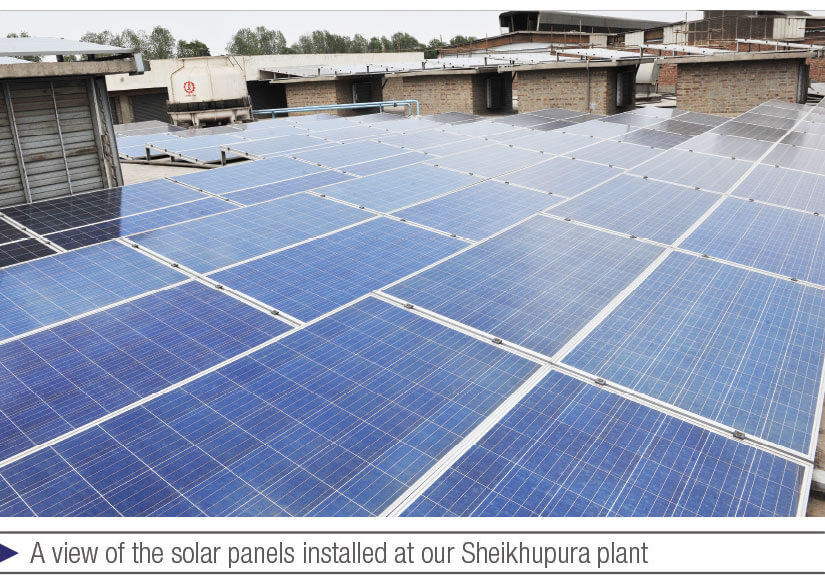
LED Lights
At our assembly plant, previously fluorescent tube lights and mercury bulbs were used for lighting. In 2017, 50% of such lights and bulbs were replaced by energy efficient LED tube rods and high-bay lights. This year, the ratio has improved to 70%. Whereas, at engine machining plant, 100% lighting is being done through LED tube rods and high-bay lights. Further, arrangements have been made to use day light when possible. This has helped us to save 2,598 GJ a year, whilst 331 tons of CO2 emissions are reduced.
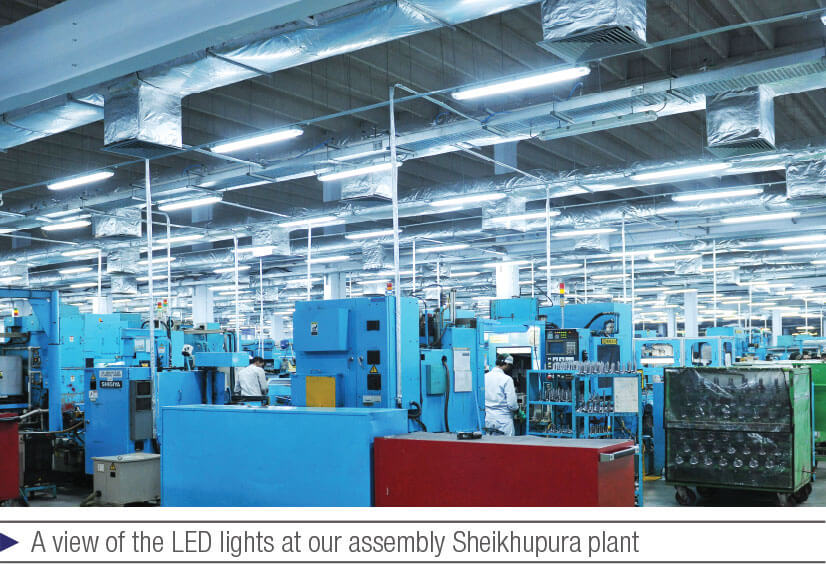
Energy Air Compressor
Previously, separate air headers were installed for 5 bars and 7 bars air pressure, which had improved the energy efficiency. Under this, 5 bars air pressure was supplied to four areas at Sheikhupura (SKP) plant. This year, 5 bars air pressure is supplied to 7 areas at SKP plant which has improved the energy efficiency by 354 GJ per year and reduced CO2 emissions by 45.5 ton per year.
Synthetic Natural Gas (SNG)
We have enhanced the LPG efficiency by adding air at specific ratio to LPG which results in SNG. It results in reduction of LPG consumption by 21%.

Waste Heat Recovery System
For achieving optimal results, we keep restructuring and redesigning the heat distribution plan by continuous study and analysis. During the year, the excess steam generated from waste heat recovery boilers has been connected to pre-treatment line paint shop and is being used as a source of heat in place of fire boiler and burners. This measure has allowed us to reduce CO2 emissions by 481 tons in a year.

Material, Effluents & Waste
The environment friendly use of raw materials is taken into account as early as the development phase through life cycle engineering. We shape our supply chain and material cycles accordingly, allowing us to gradually increase the use of secondary raw materials in our production processes. Natural resources are being used in the most efficient manner with the objective to minimize depletion of the planet resources. We are working to replace artificial materials with renewable materials wherever it makes technical, business and environmental sense and is socially viable. We closely monitor the consumption of raw materials having substantial impact on the environment and treat them according to our environment policy.
Waste resulting from our production processes mainly includes waste water, metal, plastic, rubber scrap, packing and used oil. Waste water is treated through Waste Water Treatment Plant before it releases in sewerage drains. The remaining waste and effluents are discharged through incineration, recycling, landfill and disposal to legitimate contractors at certified waste disposal facilities. During the year, 10,357 tons
of waste was released with the reduced intensity of 10% per motorcycle. There were no significant spills during the year.
Minimizing packing waste
In our production processes, we use recycled packaging for parts to reduce waste and minimize our impact on the environment. The use of returnable packaging whenever possible has reduced our packaging waste by 3.5 tons per year.
Aluminum Wastage
In aluminum casting process, aluminum is obtained in raw shape initially, during the finishing process wasted aluminum is reused with new material at specific ratio leading to wastage reduction and efficient usage of non-renewable material. By this arrangement solid waste has been reduced by 85.3 tons in a year.
Incineration
Incineration is performed to treat solid hazardous waste with controlled combustion, reduce the release of greenhouse gases and reduce landfill space. In the process of incineration solid waste is collected, crushed and moved into heating chamber. Ash generated by burning process is disposed, while gases produced are filtered and exhausted through the chimney. We have successfully incinerated 130 tons of hazardous waste this year, in coordination with EPA certified third party.
Water
We seek to reduce our water footprint by promoting water-saving practices among employees and adopting water-efficient technologies and equipment wherever possible. The majority of our water use can be attributed to our production processes, cooling, and water consumed by our employees. Our main areas of action are thoughtful use and reuse of water and safe disposal of treated waste water. Most of the water consumed is drawn from earth which is not designated as a protected area whereas the size or volume of the water body cannot be estimated reliably.
During the year, 645,006 cubic meters of water was consumed with a reduced intensity of 15% per vehicle as compared to the last year. After proper treatment, we release the water, used in manufacturing process, back to environment. Such treatment removes pollutants from the water and makes the same suitable for safe drainage. During the year, 90,300 cubic meters (14%) of the water was recycled. Water consumption and discharge is recorded through flow meters installed at water tanks and treatment plant, respectively.

Waste Water Treatment Plant
Water is used throughout our production processes which results in waste water. To prevent the waste water from being discharged as produced, waste water from all over the plant is collected and treated to remove the harmful pollutants, at Waste Water Treatment Plant. We, as a responsible organization abide by the legal requirements of waste water treatment as well as meet “Punjab Environmental Quality Standards”. In a year, around 554,705 cubic meter of water is treated and safely drained into the sewerage.

Reusing water
As part of various initiatives being undertaken to reduce water consumption, water used in cooling of dies is collected in reservoirs, filtered and reused. Through such measures, around 58 litres per vehicle of water is being saved every year.
Further, at pre-treatment line of paint shop, parts are treated by dipping into the water tanks. During this process, water spills when parts are dipped into the water tanks. We have developed a process through which spilled water is collected, filtered and reused. By reusing the spilled water, 1.26 litres per vehicle is being saved.

Biodiversity
We believe that minimizing the environmental impact resulting from our products and business activities represents the greatest contribution, we can make to biodiversity conservation. We recognize that emissions and other pollutants are two of the greatest impacts of business activities that threaten biodiversity. Consequently, we are working systematically to minimize both impacts.
Further, we have been putting a great deal of effort into activities that have led to the conservation of biodiversity. Over the years, we have been undertaking various initiatives such as tree-plantation and water-recycling. During the year, a project of plantation of 18,000 trees has
been initiated out of which 4,000 trees are already planted within the premises of Sheikhupura plant. Remaining trees are planned to be planted at Schools, Government Institutes and Reservoirs in collaboration with the Environmental Protection Agency. We will be responsible for plantation, protection and maintenance of the trees.
Both our manufacturing plants are located away from protected areas to minimize the effects of CO2 and other greenhouse gases on the protected areas.

Management Approach
The Company views environmental stewardship as a key social responsibility alongside product safety and quality. By setting clear objectives and advancing concrete environmental initiatives in line with our Environment Policy and Honda (Global) Environmental Vision, we follow the principles of reduce, reuse, recycle and responsible disposal. AHL pursues needed technologies and processes to help minimize the impact of its products on people and communities throughout their lifecycle while ensuring environment friendliness. Cutting-edge technologies and effective environmental management measures help us to minimize the negative effects of motorcycle production on the environment and on resources.
AHL is also implementing green policies at all its locations, including business partners and improving awareness for protecting the environment through continuous training and development programs.
In recognition of our healthy environment practices, we have been awarded with Corporate Social Responsibility Award for the year 2016 by National Forum for Environment & Health.
Environment Management System
AHL seeks to minimize the environmental impact of its business activities through product life cycle analysis via a comprehensive Environment Management System (EMS). The pursuit of these environmental sustainability goals is blazing a trail of ongoing improvement of environmental performance. EMS allows AHL to organize and analyze, in a timely manner, the impacts of various environmental issues on its business, particularly climate change and energy, and to develop and execute specific measures for addressing such issues.
Pursuing its vision of environment protection, AHL objectively assess its current environmental problems, analyze the kinds of risks and opportunities they represent, and respond in various ways. AHL is promoting environmental initiatives in both business activities and product development, as not only this helps mitigate risks to our business continuity, but also this present opportunity to create and expand new business opportunities.
Regulatory compliance is fundamental to the production and in-use performance of AHL products, and to the continuance of AHL’s operations. AHL has developed a comprehensive framework for identification and compliance of requirements of various local regulations (Pakistan Environment Protection Act 1997, Factories Act 1934 etc.) and international standards (ISO 14001: 2004, Honda Environment Performance Standards etc.)
AHL considers it essential to engage in such business activities and decide and execute specific measures, having sufficiently assessed these risks and opportunities.
In order to ensure compliance with requirement of EMS, scheduled and surprise internal audits are conducted during the year. Moreover, annual environmental audit was also conducted by independent third party who revealed zero non-compliance with applicable regulations and standards. Further, no grievances about environmental impacts were filed through our formal grievance mechanisms during the reporting period.
To support effective operation of EMS, AHL has developed Environment Policy for the promotion of protection of environment as follows:
Environment Policy

Product Life Cycle Assessment
AHL procures various parts and materials through the manufacturing process, utilizes natural resources, including various raw materials, water, energy and chemical substances, among others, to provide products to its customers. Such business activities result in environmental impacts at each stage in the process. The Company continues to provide more highly value-added products and services while at the same time seeking to understand the environmental impacts resulting from its business activities and implementing measures to reduce such impacts.

Material, Effluents & Waste
AHL has incorporated sustainability criteria into its development, procurement of raw materials and development of new formulae and application. Materials having high impact on the environment are monitored in pursuance of the Company’s environmental policy.
The major raw materials used in vehicle manufacturing are steel, coils, ferrous and non-ferrous castings, paints and thinners. The Company sources a large number of finished components used in assembly operations from various suppliers. The Company strives for material optimization, efforts for which starts at product development stage. The material usage is periodically reviewed at the manufacturing stage and various initiatives are undertaken to further reduce material use through reuse and re-engineering. However, no recycled material was used for the production during the year.
Further, The Company waste includes waste water, scraps Iron, high BOD, COD, Chloride, oil & grease etc. The Company uses waste water treatment plants to control the water contamination as per “National Environmental Quality Standards” before releasing it into sewerage drains. The remaining waste and effluents are discharged through incineration, recycling, landfill and sale to legitimate contractors at certified waste disposal facilities. During the year, 9,908 tons of waste was released with the reduced intensity of 10% per motorcycle. There were no significant spills during the year.

Energy
The energy consumption during the year was 407,958 GJ. Energy consumption has increased due to increase in production. However, the energy consumption per motorcycle has decreased.
Energy Conservation Initiatives
The Company is taking various energy conservation measures in production processes, introducing highly efficient equipment and adopting energy saving lighting. Due to effective energy conservation measures, the energy consumption per motorcycle has been reduced by 7% from 476 KJ to 443 KJ per bike. During the year, total energy conservation was 5,359 GJ with the help of following initiatives:

Renewable Energy Source
Solar Panels have been installed which will generate 230KW of clean and renewable energy. This will reduce the use of conventional non-renewable energy sources due to which annual CO2 emission will reduce by 269 tons.

Fuel Efficient Diesel Generator
Installation of new fuel efficient diesel generator has resulted in 7% reduction in diesel consumption for power generation. The new diesel generator has fuel consumption of 0.280 L/KWH as compared to 0.302 L/KWH of previous generator. This will result in saving of 180 KL diesel per year, which will result in energy saving of 2510 GJ per annum and 172.45 ton/year of CO2.

Energy Efficient Air Compressor
An energy efficient air compressor has also been installed in the Sheikhupura Plant which would expectedly bring 898 GJ (9%) of saving in energy and 570 ton/year reduction in CO2 emission.

Another area which improved compressed air efficiency is the installation of separate air headers. Previously, common compressed air pressure was being supplied to all areas, whereas, different areas require different air pressures. For this purpose, separate air headers have been installed for 5 bar and 7 bar air pressures. This further reduced the CO2 emission by 110 ton/year.

Installation of LED Lights
In order to reduce the energy cost in assembly plant, LED lights have been installed. Previously, fluorescent tube lights and mercury bulbs were used for illumination which consumed more energy. 50% of old lights have been replaced with LED lights. Furthermore, arrangements have also been made to utilize sky light during daytime hours to reduce the usage of conventional lighting sources. These arrangements will reduce the energy consumption by 1951 GJ/year and CO2 emission by 251 ton/year.
Water
AHL is making progress in assessing and understanding its overall water footprint, which helps to identify impacts across the value chain. Being a leader in industry, the Company recognizes that efficiency is not the only relevant measure. Water quality, water security and access to water and sanitation also impact our supply chain and our business, affecting everything from the availability of raw materials to the health and well-being of workers and their communities. Most of the water consumed is drawn from earth which is not designated as a protected area whereas the size or volume of the water body cannot be estimated reliably. Additionally, there were no significant spills during the year.
During the year, 657,124 cubic meter water was consumed with a reduced intensity of 8% per motorcycle as compared to the last year. The Company returns water that it uses for manufacturing processes to the environment at a level that supports aquatic life and agriculture. The Company recycles waste water for garden and landscape irrigation. During the year, 52,560 cubic meters (8%) of the water was recycled.

Emission
Atlas Honda is actively committed to minimizing the impact of its manufacturing operations on the global environment, including waste generation, air and water pollutant releases, energy and natural resource consumption, and emissions of greenhouse gasses, primarily CO2. All products of the Company comply with EURO II standards of carbon emission, in addition to being in compliance with Pakistan Standards for Quality Control in respect of CO2 emission, noise levels and smoke. The emissions during the year were 25,644 tons of CO2, which was 8,597 tons less as compared to last year in terms of production.

Biodiversity
AHL pays close attention to biodiversity as an issue relating to environmental conservation, because its business activities can have an impact on vital natural resources. Resource exploitation, runaway development, pollution, climate change – these and many other impacts of human activities threaten biodiversity. As a manufacturer of personal mobility products, AHL see its business activities as being most closely associated with the growing environmental impacts resulting from emissions of greenhouse gases (GHGs) and various other pollutants. Minimizing the environmental impacts that result from its business activities and products represents the greatest contribution that AHL can make to preserve and promote biodiversity. This awareness challenges us to develop more environmentally responsible technologies and make continuous improvements to the environmental performance of our operations. Both of our manufacturing plants are located in industrial areas, away from the protected areas, with low biodiversity. Tree-planting and water-recycling initiatives at its plants and demonstrate the deep roots of our commitment to environmental conservation and living in harmony with local communities.


